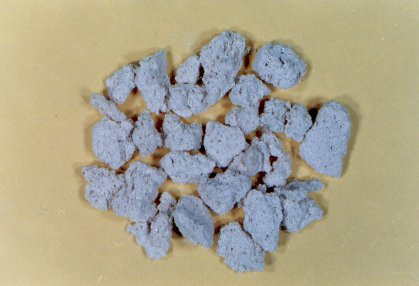Design and maintenance of tanks and clarification equipments of marine living fish for food.
村上定瞭(水浄化フォーラム), Sadaaki Murakami (Water & Solutions Forum)
2.魚の備蓄環境
2.1 温度
2.2 溶存酸素
2.3 二酸化炭素
2.4 pH
2.5 汚濁物質
2.6 塩分
2.7 明暗
3.活魚水槽の浄化方法
3.1 活魚水槽の水質
3.2 処理方式の特徴
3.3 生物膜法の原理と特徴
4.魚介類の種類と水槽の形状
4.1 遊泳魚
4.2 底生魚
4.3 カニ・エビ
4.4 貝類
4.5 タコ・イカ
5.生物膜式浄化装置の設計
5.1 装置の材質
5.2 微生物担体
5.3 ろ床容積
5.4 浄化装置の形状
5.5 水循環時間
5.6 曝気
6.維持管理
6.1 生物膜の植種と熟成
6.2 魚の収容量
6.3 水質分析
6.4 pHの管理と海水の交換
6.5 微生物担体の再生
6.6 カビや病原菌の発生
7.活魚水槽と浄化装置の具体例
7.1 遊泳魚用大型水槽
7.2 遊泳魚用小型水槽
7.3 底生魚・貝類・カニ・エビ用水槽
8.おわりに
参考文献
2. Fish stocking environment
2.1 Temperature
2.2 Dissolved oxygen
2.3 Carbon dioxide
2.4 pH
2.5 Pollutants
2.6 Salinity
2.7 Light and dark
3. Clarification method of live fish tank
3.1 Water quality of live fish tank
3.2 Characteristics of processing method
3.3 Principle and characteristics of biofilm method
4. Species of fish and shapes of tanks
4.1 Swimming fish
4.2 Benthic fish
4.3 Crab and shrimp
4.4 Shellfish
4.5 Octopus and Squid
5. Design of biofilm clarification device
5.1 Deivice materials
5.2 Microbial carrier
5.3 Filter bed volume
5.4 Shapes of clarification device
5.5 Water circulation time
5.6 Aeration
6. Maintenance
6.1 Biofilm seeding and breeding
6.2 Fish capacity
6.3 Water quality analysis
6.4 pH control and seawater exchange
6.5 Regeneration of microbial carrier
6.6 Outbreak of mold and pathogen
7. Examples of live fish tank and clarification device
7.1 Large tank for swimming fish
7.2 Small tank for swimming fish
7.3 Aquarium for benthic fish, shellfish, crab and shrimp
8. Conclusion
References
1.はじめに
魚介類を生きたまま輸送・備蓄して、生魚料理とする活魚ブームが全国各地で普及して久しい。また、活魚の需要の増加により輸入活魚量も年々増加している。
活魚は産地(漁場、養殖場)、漁港、魚市場を経て活魚店あるいは料理店において一般消費者に供せられる。この流通経路で輸送(船舶、車両、航空等)および備蓄が繰り返される。特殊な魚介類を除き、輸送・備蓄いずれにも水槽が必要である。
浄化装置なしで魚を曝気水槽で生かす場合(水量の3~6%程度収容)、魚の排泄物(二酸化炭素、吐出物、粘液質や糞・尿)により水質が汚濁するので、一般的な魚の生存時間の限界は、酸素の補給が十分であっても、10~20時間である。したがって、魚を生きたまま長時間に渡って備蓄する場合には、浄化装置のついた水槽が必要である。
本ページでは、海産魚介類の活魚水槽および浄化装置の設計と維持管理について、その概要を記載する。海水を取り上げるたのは、次のような理由による。
(1) 淡水は水道水等により容易に入手できるが、海水の入手には手間がかかる。
(2) 一般的には浄化装置には生物膜法が用いられるが、海水での微生物の活性度が、淡水と比較して低い。
(3) 微生物フロックが淡水と比較して柔らかく、微生物担体から剝離して水槽内に浮遊しやすい。
ここでは、漁港、市場、活魚店、料理店などに設置される活魚水槽の浄化装置について、以下の項目に関して解説する。
(1) 魚の備蓄環境、(2) 活魚水槽の水質と浄化方法、(3) 魚介類の種類と水槽の形状、(4) 生物膜式浄化装置の設計、(5) 維持管理。
輸送用の水槽については、水質の浄化以外に、(1) 移し替え、(2) 震動や揺れ、(3) 環境の変化(収容容器のサイズ・形状、水温、溶存酸素、塩分、明暗など)に対する配慮が必要であり、これらについてはページ数の関係上、別の機会に解説する。
また、水浄化の基本となる本サイト内の観賞魚水槽も参考とされたい。さらに、水浄化設備の設計・維持管理に係る生物膜法の解説および水質管理に必要な簡易水質検査も参考とされたい。
1. Introduction
It has been a long time since the live fish boom that transports and stocks fish alive and uses them as raw fish dishes have spreaded all over Japan. In addition, the ammount of imported live fish is increasing year by year due to the increase in demand for live fish.
Live fish dishes are available to general consumers at fish shops or restaurants through fishing ports and fish markets from the fishery grounds. Transportations (by ships, vehicles, aviation, etc.) and stockpiling are repeated along these distribution routes. Except for special fish, tanks are required for both transportation and storage.
When using an aeration tank without clarification device (accommodating about 3 to 6% of the water volume), the water quality is polluted by fish excrement (carbon dioxide, mucus, vomit and feces/urine), so the limit is 10 to 20 hours, even with adequate oxygen supplementation. Therefore, when fish are stored alive for a long time, a water tank is required to be equipped with a purifying device.
This page provides an overview of design and maintenance of live fish tanks and clarification devices for marine fish. The reasons for taking seawater up is as follows.
(1) Fresh water can be easily obtained from tap water, but it takes time to obtain seawater.
(2) Generally, the biofilm method is used for clarification device, but the activity of microorganisms in seawater is lower than in freshwater.
(3) Microbial film in seawater is softer than in fresh water and easily detachable from the microbial carrier filled in clarification device.
Here, we will explain following items regarding the clarification devices for live fish tanks installed in fishery ports, fish markets, live fish shops and fish restaurants, etc.
(1) Storage environment of live fish, (2) water quality and clarification method, (3) type of fish and shape of storetank, (4) design of biofilm clarification device, (5) maintenance of the system.
Regarding tanks for live fish transportation, there are considerations for (1) fish transfer from a tank to another tank, (2) vibration and shaking of water, and (3) environmental changes such as size and shape of tank, water quality of temperature, dissolved oxygen, salinity, light and dark, etc. Theese will be explained on another occasion because of the number of pages.
Refer to the ornamental fish aquarium on this site, which is the basis of water clarification. Also refer to the explanation of the biofilm reactors concerning the design and maintenance of water clarification devices and the onsite water quality analyses necessary for water quality management.
2.魚の備蓄環境
2.1 温度
温度は、魚の備蓄環境因子の中で最も重要なものである。最適な生育温度は、魚の種類と季節によって異なる。しかし、一般的な活魚の備蓄では多くの種類の魚を扱うので、それぞれの魚種に最適な温度に調節した数多くの水槽を設置することが困難である。また、多くの種類の健康魚は、水質が良好であれば水槽収容後、数時間~数日程度で摂餌活動を行う(魚種により大きな差異がある。1~2kgの養殖タイを実験室の水槽へ移した経験では、ペレット状人工飼料の摂餌活動を開始するまで1ヶ月を要した。)。餌を投与すると水質が悪化するので、通常備蓄中餌は与えない。最適生育温度では魚の代謝活性が高く、体力を消耗し備蓄中に痩せたり味が落ちたりする。また、温度が高くなるほど細菌増殖が活発となり、感染症が起こりやすくなる。
以上のことから、気温が20℃以上になる季節では冷却を行って15~20℃のある温度で一定に保つのが一般的である。冬期では温度コントロールは行われていないことが多い。魚介類は温度変化に弱いので、流通経路内の水槽温度は同じ値に設定されている。
2. Fish stock environment
The main factors of the fish stocking environment are as follows.
2.1 Temperature
Temperature is the most important environmental factor in fish stock. The optimum growth temperature depends on the type of fish and the season. However, since many kinds of fish are handled in the stockpile of general live fish, it is difficult to install many tanks adjusted to the optimum temperature for each fish species. In addition, many types of healthy fish begin eating activities in several hours to days after they are stored in the aquarium if the water quality is good. There is a big difference depending on the fish species. In experience of the editor, 1 to 2 kg of red sea bream took one month to start the eating activity to a pelleted artificial feed. However, since the water quality deteriorates when feed is administered, no feed is normally given during stockpiling. At an optimal growth temperature, metabolic activity of fish is high, which causes exhaustion of physical strength, resulting in loss of weight and taste during storage. In addition, the higher the temperature, the more active the bacterial growth and the more likely it is that an infection will occur.
From the above reason, in the season when temperature is over 20°C, it is common to cool and keep it constant at a temperature of 15 to 20°C. Temperature control is often not done in winter. Since fish and shellfish are vulnerable to temperature changes, the tank temperature in distribution route is set to a certain value.
2.2 溶存酸素
溶存酸素も備蓄環境因子の重要なものである。一般的には、飽和溶存酸素濃度近くに維持するように空気曝気や液体酸素の投入が行われている。しかし、最も重要なことは溶存酸素濃度の急減が、魚にとって危険である。水槽内の水流速度が遅く魚の対流遊泳が激しくない場合には、5mg/L以上であれば特に問題はない。
なお、飽和溶存酸素濃度は気圧・水温・溶存塩類濃度などによって異なる。蒸留水における1気圧・20℃での飽和溶存酸素濃度は8.84mg/Lである。
2.2 Dissolved oxygen
Dissolved oxygen concentration DO is also an important environmental factor for stockpiling. In general, air aeration or liquid oxygen injection is performed so as to maintain DO close to the saturated DO value. But most importantly, a sharp drop in dissolved oxygen concentration is dangerous to fish. If the water flow velocity in the tank is slow and the fish swimming is not vigorous, there is no particular problem as long as it is 5 mg/L or more.
Saturated DO depends on atmospheric pressure, water temperature, dissolved salt concentration, etc. In distilled water, the saturated DO is 8.84 mg/L at the atmospheric pressure and 20°C.
2.3 二酸化炭素
二酸化炭素CO2の分圧が上がると水中の酸素との交換が妨げられる。未解離のCO2が30~50mg/Lになると魚の動きが鈍くなり、50mg/Lを超えると魚に触れても反応しなくなる。さらに150mg/L以上になると、酸素が十分存在してもへい死する [山崎, 1982]。このようなCO2分圧の増加は密封型の容器で活魚を輸送する際に起こる現象である。開放型水槽で曝気を行う場合には、未解離のCO2は気泡中へ拡散し、気泡とともに大気中へ揮散するので問題となることはない。
2.3 Carbon dioxide
An increase in the partial pressure of carbon dioxide CO2 hinders its exchange with oxygen by aeration. When the undissociated CO2 becomes 30 to 50 mg/L, the fish movement becomes sluggish, and when it exceeds 50 mg/L, the fish does not react even if touched. At 150 mg/L and above, even when sufficient oxygen is present, fish dies [Yamazaki, 1982]. Such an increase in CO2 partial pressure is a phenomenon that occurs when transporting live fish in a sealed container. When aeration is performed in an open water tank, undissociated CO2 diffuses into the bubbles and vaporizes with the bubbles into the atmosphere, so there is no problem.
2.4 pH
淡水魚はpHの変化に対して順応力があるが、海水魚の順応力は弱いと言われている。これは、海水のpH緩衝力のある電解質が多く、海水のpH(海域や深度により異なるが、7.5~8.4)は変動が少ないからである。活魚として扱われる多くの魚はpH6~9の範囲で備蓄可能である。しかし、pH変化は海水内の電解質の電離平衡を変化させ、魚の生理に大きな影響を与えるので、pHの急激な変化は避けるべきである。
pH変化で注意しなければならないのは、アンモニアとの関係である。アンモニアの毒性はNH3に起因しており、NH4+は毒性を示さない [Colt, 1976]。NH3とNH4+の平衡はpHに依存し、pH上昇に伴いNH3濃度が高くなる。微生物によるアンモニアの酸化によりpHが低下し、pH低下とともにこの酸化反応が抑制され [Enrique, 1979; 河合, 1965 ; Richard, 1975]、アンモニアが少しづつ蓄積する [平山, 1970]。特に海水の主なpH緩衝源である炭酸水素イオンがほぼ消費されるpH5.5以下においてはアンモニアの酸化は殆ど進行しない。pHが低いときにはNH3濃度が低いため毒性を示さない。しかし、この水をアルカリで中和してpHが急激に上昇すると、NH3濃度が高くなり魚がへい死することがあるので、注意する。
2.4 pH
It is said that rapid change in pH give a weak effect to freshwater fish, but give a strong effect to seawater fish. This is because seawater has many pH buffering electrolytes, and the pH of seawater (7.5 to 8.4, depending on the sea area and depth) varies little. Live fish can be stored in a pH range of 6 to 9. However, rapid change in pH should be avoided, because change in pH occurs the ionization equilibrium of electrolytes in seawater and has a great influence on the physiology of fish.
One thing to be aware of that change in pH is the relationship with ammonia. Ammonia toxicity is due to NH3 and but NH4+ is not toxic [Colt, 1976]. The equilibrium between NH3 and NH4+ depends on pH, and NH3 concentration increases with increasing pH. The pH is lowered by the oxidation of ammonia by microorganisms, and this oxidation reaction is suppressed as the pH is lowered [Enrique, 1979; Kawai, 1965; Richard, 1975], and ammonia is gradually accumulated [Hirayama, 1970]. In particular, at pH 5.5 or below where hydrogen carbonate ions, which is the main pH buffer source of seawater, are almost consumed, ammonia oxidation hardly progresses. When the pH is low, it does not show toxicity because the NH3 concentration is low. However, be aware that if this water is neutralized with alkali and the pH rises sharply, the NH3 concentration will increase and fish may die.
2.5 汚濁物質
浄化装置がない、または不適切な装置で運転された水槽で、魚を備蓄すると魚の粘液質、剝離した組織片、糞、尿などの排泄物が高濃度となり、次のような現象を引き起こす。
(1) 懸濁性物質は、えらに付着してその有効ガス交換面積を減少させたり、水-血液間距離を大きくして酸素摂取効率を低下させる。
(2) 懸濁性物質により水の透明度が悪くなると、魚の視界が悪くなり、魚同士が接触したり水槽の壁に当たり眼球の白濁や皮膚の損傷が起こり、細菌感染が起こり易くなる。また、ストレスの原因となり、魚が落ち着かず体力の消耗となる。
(3) 懸濁性・溶解性と問わず有機物質濃度の増加は、病原菌やバクテリアの増殖を促進する。また、これらの増殖は溶存酸素を消費する。
(4) アンモニアは毒性が強く、魚の種類によって異なるが、NH3が数mg/Lを超えると数時間で死に至る [Poxton, 1982]。
2.5 Pollutants
When fish is stored in a tank that has a poor clarification device or the device is operated under an unsuitable condition, excrements such as mucus, detached tissue pieces, feces, and urine become highly concentrated, causing the following phenomena.
(1) Suspendable substances adhere to fish gills to reduce the effective gas exchange and oxygen uptake efficiency.
(2) When the transparency of water deteriorates due to a suspending substance, the visibility of the fish deteriorates, the fish come into contact with each other, the white of the eyeball becomes cloudy and the skin is damaged, and bacterial infection easily occurs. In addition, it causes stress, and the fish becomes restless and consumes physical strength.
(3) An increase in the concentration of organic substances, regardless of whether they are suspended or soluble, promotes the growth of pathogens and bacteria. Also, these growths consume dissolved oxygen.
(4) Ammonia is highly toxic and varies depending on the type of fish, but when NH3 exceeds several mg/L, death occurs within hours [Poxton, 1982].
2.6 塩分
一般海水の塩分濃度は3.3~3.7%である [Nicol, 1967]が、活魚水槽では2.7~4%の範囲であれば問題はないようである。水分の蒸発により、活魚水槽では塩分濃度が高くなるが水道水で希釈すればよい。また、床に設置した水槽において、水道水が混入したケースもある。
2.6 Salinity
The salinity of general seawater is 3.3 to 3.7% [Nicol, 1967], but it seems that there is no problem in live fish tanks if it is in the range of 2.7 to 4 %. Although the salt concentration in the live fish tank increases due to evaporation of water, it may be diluted with tap water. On the other hand, take attension that, in some cases, tap water is mixed in the fish tank installed on the floor.
2.7 明暗
魚は、照度の急激な変化に対して敏感である。一般に、水槽は屋内に設置され照明が行われる。営業時間終了後、全てを一斉に止めることは魚に動揺を与える。段階的に照明を落とすことに留意する。また、遊泳魚は真っ暗な状態では魚にストレスを与えるので、薄明かりの状態にしておくのがよい。逆に、営業開始の際には、段階的に照明をつける。
2.7 Light and dark
Fish are sensitive to rapid change in illuminance. Generally, fish tanks are installed indoors and are illuminated. Stopping all at once after business hours will upset the fish. Note that the lights are turned off in stages. In addition, darkness gives stress on swimming fish and it is good for them to be stored in dim light. On the contrary, when the business starts, the lights are turned on in stages.
3.活魚水槽の水質と浄化方法
3.1 活魚水槽の水質
活魚水槽の水質条件は魚の種類により大きく異なるが、一般的に取り扱われて活魚については、次のような条件が必要であろう。現場での簡易水質検査・測定については、別ページに掲載しているので、参考とされたい。
(1) 有機物濃度は8mg/L以下が望ましい。
(2) アンモニア濃度は海水の補給等によりpHが変動するので、pHに関係なく0.2mgNH3-N/L以下が望ましい。
(3) 懸濁性物質濃度は5mg/L以下が望ましい。
(4) pHは6.5~8.5の範囲が望ましい。
(5) 溶存酸素濃度7mg/L以上が望ましい。
以上の値は、本編集者が山口県内の活魚店や料理店に設置してある活魚水槽と魚の状況(生存日数や外観的損傷など)の調査により、経験的に求めたものである。活魚水槽は養殖等と異なり短期間、魚を生存させて備蓄するものであるから、水質を厳密に規定することは困難である。なお、魚の生育環境に関しては、Poxtonらの総説 [Poxton,F.S., 1982]がある。
3. Water quality of live fish tank and clarification method
3.1 Water quality of live fish tank
The water quality conditions of live fish tanks vary greatly depending on fish species, but since they are generally handled, the following conditions will be necessary. The easy water quality inspection/measurement at the site is described on another page (see 1. Introduction), so refer to it.
(1) It is desirable that the concentration of organic substances be 8 mg/L or less.
(2) The ammonia concentration is 0.2 mgNH3-N/L or less, regardless of pH, because the pH change due to replenishment of seawater.
(3) Concentration of suspending substance should be less than 5 mg/L.
(4) pH is preferably in the range of 6.5 to 8.5.
(5) Dissolved oxygen concentration of 7 mg/L or more is desirable.
The above values are empirically determined by the editor by investigating the conditions of tanks and fish situations, such as appearance dameges and survival days, at live fish shops and restaurants in Yamaguchi Prefecture, Japan. Unlike aquacultures, live fish tanks store fish by keeping them alive for a short period of time, so it is difficult to specify water quality strictly. Regarding the growth environments for fish cultures, there is a general review by Poxton et al. [Poxton, F.S., 1982].
3.2 水処理方式の特徴
活魚水槽の汚濁物質を物理・化学的に処理するには、高度な技術と経費が必要である。一般的な方法は、生物の機能を利用して無害な物質へ変換する。この方法は装置も簡単で維持管理も容易であるが、排水処理等と比較して、その処理方法の大きく異なる事項として次のようなことが挙げられる。
(1) 原水中の汚濁物質濃度が極めて低い。
(2) 排水処理等では、法令基準等に対応し、浄化に利用される微生物機能の面から設計されるが、活魚水槽では魚の生理・生態の視点から設計される。もちろん、食品安全基準を満たすことは言うまでもない。
(3) 排水処理等では、多くの場合、処理水は放流する開放系あるのに対して、活魚水槽では処理水は再び水槽に戻し、系内を循環する閉鎖系である(図1)。
(4) 閉鎖系であるので、少しづつ阻害物質の蓄積とpHの低下が起こり、微生物の活性度が低下する。
3.2 Characteristics of water treatment method
Physical and chemical treatment of pollutants in live fish tanks requires advanced technology and expense. A general method is to convert the pollutants into harmless ones by utilizing the function of organisms. Although this method has a simple apparatus and is easy to maintain and manage, the followings are the major differences in the treatment method compared to wastewater treatment.
(1) The concentration of pollutants in raw water is extremely low.
(2) In wastewater treatment, it is designed from the viewpoint of the microbial function used for clarification in compliance with legal standards, but in the live fish tank, it is designed from the viewpoint of fish physiology and ecology. Of course, it goes without saying that it meets food safety standards.
(3) In wastewater treatment the system is open type that discharges the treated water, whereas in live fish storage, the system is closed type where the treated water is returned to the fish tank again (Fig.1).
(4) Since it is a closed system, accumulation of inhibitor and pH decrease occur little by little, and the activity of microorganisms decreases.

図1 処理システムの比較 Fig.1. Comparison of water processing systems
A: wastwater, B: Live fish
3.3 生物膜法の原理と特徴
水槽内の汚濁物質を極めて低い濃度に維持する処理方式としては、経済的にも魚に対しても、生物膜法が最も適しており、従来よりこの方式が採用されている。
生物膜法は、下記に示す図5に示すように生物担体を充填した槽内(ろ床)に海水を通水し、担体表面に付着および担体間隙に保持されて増殖した好気性微生物群(以下、生物膜と称する)に接触させて汚濁物質を生物学的に酸化分解して無害な物質へ変換する方法である。
この方法では、固形の有機物は溶解性の有機物に分解され微生物群に摂取同化されるとともに、呼吸反応より、二酸化炭素、アンモニアおよびリン酸に変換される。さらに、アンモニアは硝化菌により硝酸イオンに変換される [河合, 1964, 1965]。
この生物膜法の主な特徴を挙げると、次のような項目がある [北尾, 1979]。
(1) 維持管理が容易である。
(2) 低汚濁物質濃度の処理に有効である。
(3) 微細浮遊物質の捕捉能力に優れる。
(4) 負荷変動に対する対応力が高い。
(5) 余剰汚泥量が少ない。すなわち、微生物の増殖率が低い。
一方、次のような欠点がある。
(1) 生物膜が過大となると、ろ床が閉塞する。
(2) 装置が大きくなると、過大な生物膜を取り除くための再生が容易ではない。
今日では、連続多孔質セラミックス、多孔質炭素系や複雑構造プラスチックなど、水の比重に近い生物担体が開発され、再生操作が容易な曝気や逆洗による再生法が普及している。
3.3 Principle and characteristics of biofilm method
The biofilm method is most suitable economically and also for fish as a processing method for maintaining the pollutants in the tank at extremely low concentrations, and this method has been conventionally used.
In the biofilm method, as shown in Fig.5 below, seawater is passed through a tank (filter bed) filled with a biological carrier where aerobic microorganisms are adhered on the surface and/or retained in the carrier gap. Hereafter, it is referred to as biofilm and biologically oxidatively decomposes pollutants to convert them into harmless substances.
In this method, solid organic matter is decomposed into soluble organic matters, and then ingested and converted into carbon dioxide, ammonia and phosphate by mairoorganisms. Furthermore, ammonia is converted to nitrate by nitrifying bacteria [Kawai, 1964, 1965].
The main features of this biofilm method are as follows [Kitao, 1979].
(1) Maintenance is easy.
(2) Effective for treating low pollutant concentrations.
(3) Excellent ability to capture fine suspended solids.
(4) Responsiveness is high to load fluctuation.
(5) The amount of excess sludge is small. That is, the growth rate of microorganisms is low.
On the other hand, there are the following drawbacks.
(1) If the biofilm becomes too large, the filter bed will be blocked.
(2) When the device becomes large, it is not easy to regenerate it to remove excessive biofilm.
Today, there have been developed biological carriers with a specific gravity close to that of water, such as continuously porous ceramics, carbon-based porous materials and complex structural plastics those are regenerated only by aeration or water back-flushing that are easy to operate.
4.魚介類の種類と水槽の形状
魚介類を備蓄水槽の構造および形状の観点から大きく分けると、(1)遊泳魚類、(2)底生魚類、(3)カニ・エビ、(4)貝類、および(5)イカ・タコ類に分類できる。また、それぞれの魚介類はそのサイズの大小によって分ける必要がある。
4. Types of fish and shapes of tank
The fishes can be roughly divided into (1) swimming fish, (2) benthic fish, (3) crab and shrimp, (4) shellfish, and (5) squid and octopus in terms of the structure and shape of the water storage tank. In addition, each fish needs to be divided according to it’s size.
4.1 遊泳魚
タイ、ブリなどの大型の遊泳魚は、大きな水槽が必要となる。動きが活発であるため、適正量(3~6%程度)を超える魚を収容すると相互の擦れにより、皮膚や鱗を傷つけやすい。また、曝気や循環流による水流速度が大きいと激しい対流遊泳のため体力を消耗して、備蓄中に魚が痩せる。水槽内に水流がないと、魚が無秩序に遊泳して魚同士の接触が起こるので、遊泳方向を整えるため、適度な整流(図2)が必要である。
特に、アジやサバなどの皮膚が薄い魚(一般に青魚と言われる)は、皮膚に損傷を受けると、海水の浸透圧により長時間の生息が困難となり、商品価値が低下する。一般的には、専用の水槽で備蓄する事例が多い。
4.1 Swimming fish
Large swimming fish such as sea bream and yellowtail require a large tank. Since the fish movement is vigorous, if more than the appropriate amount (about 3 to 6% as volume ratio) of fish is stored, it is easy to damage the skin and scales due to mutual rubbing. In addition, if the water flow velocity due to aeration or circulation is high, the body is exhausted due to intense convection swimming, and the fish becomes thin during storage. If there is no water flow in the tank, the fish randomly swim and come into contact with each other. Therefore, a proper flow rectification (Fig.2) is necessary to adjust the swimming direction.
Fish with thin skin (generally called blue fish), in particular, such as horse mackerel and mackerel suffer damage to the skin, which makes it difficult for them to live for a long time due to the osmotic pressure of seawater, thus reducing the commercial value. In general, there are many cases of stockpiling in dedicated water tanks.
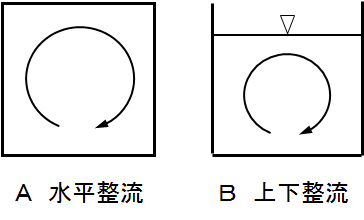
図2 遊泳方向を揃えるための整流
Fig.2. Rectification to align the swimming direction.
A: circular and horizintal, B: circular and vertical.
4.2 底生魚
ヒラメなどの底生魚は、動きが鈍く、また接触による皮膚の損傷に対して強い。したがって、水槽容積対する魚の収容率を高くすることができる。底の浅い水槽でよく、効率よくするためには図10に示すような多段の水槽を用いてもよい。また、遊泳魚と共存させても特に問題はない。
4.2 Benthic fish
Flatfish and other benthic fish are sluggish and resistant to skin damage caused by contact. Therefore, the accommodation rate of fish to the volume of tank can be increased. A shallow water tank may be used, and in order to improve efficiency, a multistage water tank as shown in Fig.10 below may be used. In addition, there is no particular problem even if they coexist with swimming fish.
4.3 カニ・エビ
エビ・カニなどの甲殻類は、他の魚介類と分離して備蓄する。カニは、ハサミで他の魚介類を傷つける。また、小型のエビ類は魚の食餌になるので混合収容はできない。エビ・カニ類は、図11に示すような水深の浅い矩形型槽を幾つかに分割した各槽に同じ種類で同じサイズのものを収容するとよい。
4.3 Crab and shrimp
Crustaceans such as shrimp and crab are stored separately from other fish. Crabs damage other kinds of fish with scissors. In addition, small shrimps cannot be mixed and stored because they will be eaten by the other fish. For shrimp and crabs, it is advisable to store the same type and the same size in each tank obtained by dividing a rectangular tank with a shallow water depth as shown in Fig.11 below.
4.4 貝類
貝類は動きが少なく、擦れなどによる損傷が少ないので重ねて収容でき、水槽容積あたりの収容率を大きくすることができる。しかし、多量の貝類を深い水槽で備蓄する場合には、水循環が悪く、酸素の供給が不十分となり酸素欠乏を起こしやすい。そこで、図3Aに示すように、水の循環を上昇流式あるいは下降流式にするとよい。また、多量の貝類を備蓄し大量の酸素補給が必要な場合には、図3BまたはCのようにして酸素を供給してもよい。
サザエは殻が厚く強化な構造であるが、アサリは殻が壊れやすいので、移し換えや詰め替えの際には、注意が必要である。
4.4 Shellfish
Since shellfish do not move much and are less damaged by rubbing, they can be stacked and stored, and the storage rate per tank water volume can be increased. However, when a lot of shellfish are stocked in a deep tank, the water circulation is poor, and oxygen supply becomes insufficient and oxygen deficiency easily occurs. Therefore, as shown in Fig.3A, the water circulation may be an upflow type or a downflow type. When a large amount of oxygen needs to be supplemented, oxygen may be supplied as shown in Fig. 3B or 3C.
The shells of top shell and oyster are thick and reinforced, but those of some kinds of clams are fragile, so care must be taken when transferring or refilling.
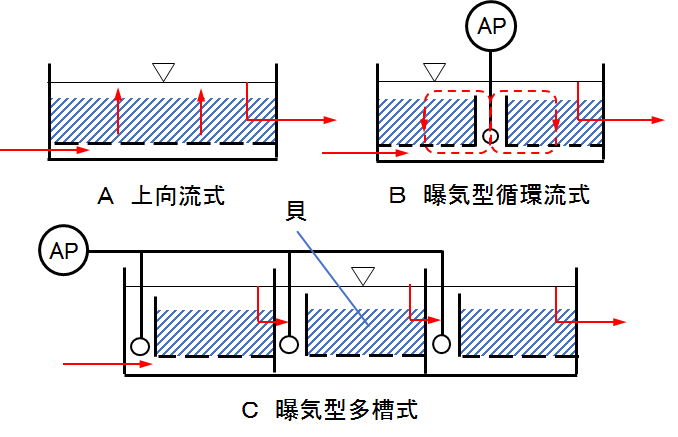
図3 貝類の大量備蓄水槽例
Fig.3. Examples of large-scale water storage tanks for shellfish.
A: upward flow, B: aeration and circulation flow (downflow), C: multple-tanks and aerations in series.
4.5 タコ・イカ類
タコは蓋付きの籠、多数の小穴が開いた箱、細めのネットに収納して遊漁用水槽に浸ける事例が多い。マダコは水質の僅かな汚濁に対して敏感で、長時間の備蓄が困難であり、特にpHの低下や硝酸イオンの蓄積に注意する [平山,1966]。
イカも魚介類の備蓄の中で最も困難なものの一つである。この理由は、備蓄環境に対して敏感であり、①厳しい水質が要求され、②水槽構造に特別な留意が必要で、③強い刺激を与えない安静な条件での備蓄が必要である。イカは前方(足の方向)にも後方(尾の方法)にも遊泳することができる。対流遊泳などにおいては前方に泳ぎ、この場合には視界があるので物体に衝突することはない。刺激等を与えると後方に高速で逃避遊泳し、視界がないので水槽の壁に衝突し、体尾・軟骨を損傷する。備蓄水槽では、出し入れ・明暗・音・振動等の刺激が常に与えられ、体尾の破損による死亡が頻繁に起こる。
これを防ぐ水槽構造として、図4に示すような長方体型や円柱型、環状溝型などの水槽とし、重要なことは水流を水平方向へ整えることである。また、静寂な環境を保ち、強い刺激を避ける。消音法としては、中小水槽では床面に直接設置しないで、音域(数十~数十kHZ)の防振材(ゴムなど)の上に設置するなど、大型水槽では砂利層等の上にコンクリート製の水槽を施工するなど、工夫をする。イカの取扱いに熟知した流通業者業者や料理店などでは、その水槽環境に配慮がなされイカの損傷を防いでいる。
4.5 Octopus and squid
Octopus is often stored in a basket with a lid, a box with a large number of small holes, or a thin net and soaked in tank together with swimming fish. The octopus is sensitive to slight pollution of water quality, and it is difficult to store it for a long time. In particular, pay attention to the decrease of pH and the accumulation of nitrate ion [Hirayama, 1966].
Squid is also one of the most difficult fish to store alive. The reason for this is that it is sensitive to the stockpiling environment, (1) strict water quality, (2) special attention to be paid to the tank structure, and (3) stockpiling under a quiet condition without strong stimulation. Squid can swim both forward (arms direction) and backward (fins dierection). In convection swimming, swim forward, and in this case, because there is a field of view, it does not collide with an object. When stimulated, it escapes backwards at a high speed and collides with the wall of tank due to its lack of visibility, damaging the tip of tail. In storage tank, stimuli such as take out of fish, light and dark, sound, and vibration are constantly given, and death frequently occurs due to damage to the tip.
As a water tank structure for preventing the damage, a rectangular, cylindrical or annular groove type is used as shown in Fig.4, and what is important is to arrange the water flow in horizontal. Also, maintain a quiet environment and avoid strong stimulation. For small or medium-sized tank, as a sound deadening method, do not install it directly on the floor, but install it on a vibration-proof material (rubber, etc.) in the sound range (tens to tens of kHz). For large-scale tank, take measures such as constructing a concrete tank on the gravel layer. Distributors, restaurants, etc. who are familiar with squid, make stockpiling environment to prevent it from being damaged.
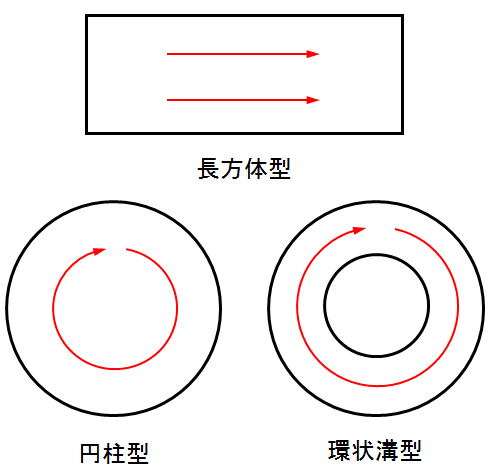
図4 イカ専用水槽の構造例
Fig.4 Structure examples of squid tanks.
長方体型 rectangular, 円柱 cylindrical, 環状溝型 annular groove.
5.生物膜式浄化装置の設計
5.1 装置の材質
海水は塩分濃度が高く、腐食性が極めて強い。したがって、水槽や浄化装置の材質は耐腐食性のものを使用する。
5m3以上の大型水槽はコンクリート製、1~5m3の中型水槽はFPR製で全面のみアクリルやPVC製、1m3以下の小型水槽はアクリル・PVC製あるいはガラス製の水槽がよく用いられる。浄化装置ではFRP製やPVC製が多い。
(1) 循環ポンプは、通常の金属製ポンプが多く用いられているが定期的に交換が必要である。ポンプ部分がプラスチック製であるマグネットドライブポンプは、海水用として優れている。
(2) 配管はPVC製パイプが用いられる。バルブ類はプラスチック製のものがよい。時々、金属製のバルブが用いられているが好ましくない。
(3) 冷却用の熱交換器は、チタン製のものがよい。銅製のものは、腐食により銅(Ⅱ)イオンが溶出し、魚に対して有害であるとともに、食材対しても不適当である。
5. Design of biofilm clarification device
5.1 Materials of device
Seawater has a high salinity and is extremely corrosive. Use corrosion resistant materials for the water tank and the clarification device.
A large tank of 5 m3 or more is made of concrete, a medium tank of 1 to 5 m3 is made of FPR, and only the entire surface is made of acrylic or PVC. A small tank of 1 m3 or less is often made of acrylic, PVC, or glass. The clarification tank is made of FRP or PVC.
(1) As the circulation pump, ordinary metal pump is used, but it needs to be replaced regularly. The magnet drive pump, whose parts are made of plastic, is excellent for seawater.
(2) PVC pipes are used for the piping. The valves should be made of plastic. Sometimes metal valves are used, which are not preferred.
(3) The heat exchanger for cooling is preferably made of titanium. Copper products are harmful to fish, as copper (II) ions are eluted due to corrosion, and are also unsuitable for foodstuffs.
5.2 微生物担体
微生物担体の選定は、活魚水槽の浄化成績の良否に係わる要素の中で最も重要で、水質はこの担体の性能に依存するといっても過言ではない。微生物担体については、生物膜法のページに記載しているので、参考とされたい。
浄化装置に充填する微生物担体には、多くのものがある。砂、砂利、砕石、石灰石、貝類、サンゴ(石灰石・貝類・サンゴはpH中和能力がある)、ゼオライト、石炭、粒状活性炭、プラスチック製担体(様々な形状がある)、セラミック製担体など、各種のものが利用されている。要するに微生物を付着し水との接触面積が大きいものであれば、どのような担体でもよい。ただし、微生物担体の選定に当たって、次のような事項に留意すべきである。
(1) 微生物を付着する表面積が大きいこと。
(2) 微細な懸濁性物質を捕捉できること。
(3) 再生が容易であること。
下水や事業所排水等の生物膜法と比較して、ろ床に対する水量の容積負荷が極めて高い(ろ床内の海水の水理学的滞留時間が一般の排水処理と比較して極めて短い)ので、生物膜の剝離が起こりやすく、さらに、海水では淡水と比較して生物膜が柔らかく脱落しやすい。このため、透明度が悪化しやすい。しかし、このような海水における生物膜の特性は、ろ床の閉塞が起こりぬくい長所でもあり、再生においても淡水と比較して装置構造や維持管理が容易なものとなる。
以上のことから、海水用としては次のような担体が適切である。
(1) 担体サイズは小さいもの。
(2) 表面に凹凸があり生物膜の剝離が起こりにくいもの。
担体として砂や砕石(サイズ1cm以下)が優れているが、装置が大きくなると逆洗や機械攪拌等による再生が困難となる。見掛け比重が水よりも僅かに大きく、曝気攪拌や上昇流速度の増加(逆洗)等により、担体が流動状態となるような担体が望ましい。
5.2 Microbial carrier
It is no exaggeration to say that the selection of microbial carrier is the most important factor for a live fish tank system, and the water quality depends on the performance of this carrier. The microbial carrier is described on the page of biofilm reactors, so please refer to it.
There are many types of microbial carriers to be filled in the clarification device. Sand, gravel, crushed stone, limestone, shellfish, coral (limestone/shellfish/coral has pH neutralizing ability), zeolite, coal, granular activated carbon, plastic carrier (various shapes), ceramic carrier, etc. In short, any carrier may be used as long as it has microorganisms attached thereto and has a large contact area with water.
The following points should be noted when selecting the microbial carrier.
(1) The surface area to which microorganisms adhere is large.
(2) Capable of capturing fine suspending substances.
(3) Easy operation of reproduction.
Compared with the biofilm reactors such as sewage and industrial wastewater, the volumetric load of water on the filter bed is extremely high, that is, the hydraulic retention time of seawater in the filter bed is extremely short compared to the time for general wastewater treatment. The biofilm peeling is likely to occur, and further, in seawater, the biofilm is softer and more likely to fall off than in fresh water. Therefore, the transparency is likely to deteriorate. Such characteristics of the biofilm in seawater are, on th other hand, advantageous so that the apparatus structure and maintenance can be easier in regeneration than in freshwater, when the filter bed is clogged.
From the above, the following carriers are suitable for seawater.
(1) Small carrier size.
(2) The surface of the biofilm carrier is uneven so that peeling of the biofilm from carrier does not easily occur.
Sand or crushed stone (size 1 cm or less) is excellent as a carrier, but it becomes difficult to regenerate it by backwashing or mechanical stirring if the device becomes large. It is desirable that the carrier has an apparent specific gravity slightly higher than that of water and can be in a fluidized state due to aeration and agitation or an increase in upflow velocity (backwashing).
5.3 ろ床容積
ろ床容積(充填した生物担体の見掛けの総容積)は、水槽の容積と魚の収容能力を決定するする重要な設計因子である。
生物担体の性能により、同じ負荷量であってもろ床容積が大きく異なる。担体サイズの大きなものは、ろ床内での海水の滞留時間を長くする必要があり、ろ床容積は大きくなる。海水用のろ床容積は水槽の1/2~1/20のものが多い。ろ床容積は、充填材(担体)の性能にもよるが、再生までの稼働日数に影響する。設置場所の面積や空間、ユーザー自身よる管理または外部委託管理(海水交換を含む)、初期投資など、総合的に勘案して設計する。
また、濁度を指標とした収容量は、タイやブリなどの遊泳魚に対して、本掲載者の実験では多孔質担体は260kg-魚/m3-ろ床の能力があるが、サンゴでは60kg-魚/m3-ろ床が限度である。循環式飼育水槽(養殖や水族館など)ではあるが、砂や砂利を用いたろ床の設計法において、アンモニア濃度を指標する方法 [佐伯,1958]や、ろ床の酸素消費量を指標とする方法 [平山,1966,1974]などが提案されている。活魚水槽と養殖池の浄化装置の設計における大きな違いは、前者は魚の量、後者は餌の量であることに注意する。
5.3 Filter bed volume
The filter bed volume (apparent total volume of filled biological carrier) is an important design factor that determines the tank volume and fish capacity.
Depending on the performance of biological carrier, the filter bed volume varies greatly even for the same load. If the carrier size is large, it is necessary to prolong the residence time of seawater in the filter bed, and this volume becomes large. The bed volume for seawater is often 1/2 to 1/20 of that of the fish tank. The bed volume affects the number of working days until regeneration, though it depends on the performance of the filler (carrier). The bed should be designed in consideration of the area and space at each installation site, and managed by users themselves or outsource (including seawater exchange) within available total cost.
In the experiment for fish such as sea bream and yellowtail by the editor, the fish capacity, by turbidity as an index, is 260 kg-fish/m3-bed of porous carrier but is 60 kg-fish/m3-bed of coral carcass. Although it is a circulation-type system for fish culture, ammonia concentration [Saiki, 1958] and oxygen consumption of filter bed [Hirayama, 1966, 1974] have been proposed as an index in designing the filter bed of sand or gravel. It should be noted that the major difference in the design of clarification device for between live fish store and aquaculture, that is, the amount of the fish for the former but of the feed for the latter.
5.4 浄化装置の形状
一般的に用いられている浄化装置の形状は、図5に示すような開放型と密封型に分類され、それらはさらに上昇流式と下降流式に分けられる。
排水の浄化装置と比較して水の滞留時間が短いので、特殊なケースを除いて浄化装置内での曝気は不要である。密封型は、コンパクトで循環水量を高く設定できる特徴がある。ただし、圧力損失を点検するための圧力計を取り付け、定格圧力に達したとき、手動操作または自動制御により再生操作を行う必要がある。
次に、ろ床内の生物量の分布は通水方向の距離が長くなるほど減少する [平山,1965; 河合,1965]。したがって、同じ容量の担体を用いた場合には、ろ床面積が広いほど微生物の保持容量が大きくなり浄化能力が増加する。
一方、運転日数の経過とともに、微生物が増殖して担体の表面や間隙に付着・保持された生物膜は通水方向に成長する。この飽和に達した生物膜がろ床の上端(上向流式)または下端(下向流式)に達すると、ろ床内の生物保持量が限界となり、生物膜が剝離して水槽内に流入するようになる。このように微生物の保持量が限界に達すると再生が必要となる。また、ろ床内に保持されている微生物量が過大となると、ろ床の圧力損失が増大し開放型では海水が仕切り板を越流するようになると、再生が必要となる。密封型では目視による点検が困難であるので、上記の通り、定格圧力に達したとき、再生が必要となる。再生までの稼働日数を長くするには、ろ床の水槽に対する容積比を大きくする必要がある。
以上のことから、浄化装置の管理が十分で再生を頻繁に行うことができる場合には、ろ床面積を広くして厚さを小さくする構造が効果的である。しかし、一般的に末端店を含めて流通経路内の活魚水槽について、専門的な管理要員は殆ど配置されていないので、数ヶ月又は半年に1回程度再生すればよいようなろ床容積が必要であろう。
タイ・ブリなどの大型遊泳魚を、1週間の平均的備蓄・販売量400kg、すなわち、1日平均60kg扱う活魚店での実験では、炭素系担体(石炭を原材料とし、実験用コークス炉で乾留・焼成し、揮発性成分が揮散した多孔質炭素担体で、粒径数cmの楕円体状担体)を用いた面積1m2のろ床では、生物膜の成長速度は1年間で1.7mであった。
5.4 Shapes of clarification device
The shape of the purifying device that is generally used is classified into an open type and a sealed type as shown in Fig.5, and they are further divided into an upflow type and a downflow type.
Since the residence time of water in a clarification device for fish is shorter than that for wastewater, aeration inside of this device is not required except for special cases. The sealed type is compact and has the feature that the amount of circulating water can be set high. It is necessary to attach a pressure gauge, however, to check the pressure loss and to perform regeneration operation by manual operation or automatic control when a rated pressure is reached.
Next, the vertical distribution of biomass in the filter bed decreases with increasing distance arong the water flow direction [Hirayama, 1965; Kawai, 1965]. Therefore, when a carrier bed having the same volume is used, the larger the across area of the bed, the larger the retention capacity of microorganisms and the more the clarification capacity increases.
On the other hand, as the number of operating days elapses, microorganisms proliferate and the biofilm, attached on the surfaces of carriers and retained in their gaps, grow in the water flow direction. When this saturated biofilm reaches the upper end (upflow type) or the lower end (downflow type) of the filter bed, the amount of living organisms in the filter bed reaches its limit, and the biofilm is separated and enters the water tank. Thus, when the amount of microorganisms reaches the limit, regeneration is required. Further, when the amount of microorganisms retained in the filter bed becomes excessive, pressure loss through the filter bed increases, and in the open type, when seawater overflows the partition plate, regeneration is required. Since it is difficult to visually inspect the sealed type, regeneration is required when the rated pressure is reached, as described above. If a user wants to increase the number of working days until regeneration, increase the volume ratio of filter bed to fish water tank.
From the above, when the clarification device is well managed and regeneration can be performed frequently, a structure is effective in which the filter bed area is wide and the height is low. In general, almost no specialized management personnel are assigned to live fish tanks in distribution channel including the end shops, so it is necessary to have a filter bed volume that can be regenerated once every several months or half a year.
The experiment for a carbon-based carrier bed showed the growth rate of biofilm was 1.7m per year against 1m2 of the cross-sectional area, at a live fish shop where large swimming fish such as sea bream and yellowtail were stored and sold in an average amount of 400 kg-fish per week, that is, 60 kg per day. This carrier was an porous and ellipsoidal shape of several cm, that was made of coal as a raw material, was carbonized and fired in an test coke oven to remove volatile components.
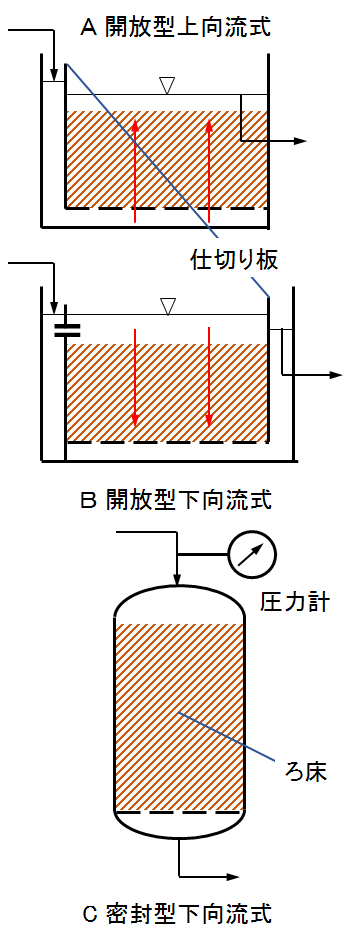
図5 浄化装置の形式 Fig.5. clarification device types.
A: open and upflow, B: open and downflow, C: closed and downflow.
仕切板 partition board or wall, 圧力計 pressure gage, ろ床 filter bed.
5.5 水循環時間
一般的にシステム内の海水循環時間は15分~2時間内の範囲に設定され、30分程度の循環時間が最も多く採用されている。また、循環時間が30分程度であれば、新しい魚の投入などにより懸濁物質が著しく増加しても、数時間以内で懸濁物質がろ床に捕捉される。しかし、循環時間を余り短くすると、生物膜の剝離が起こるので、一般的には15分以上にとる必要がある。ただし、循環時間と生物膜の剝離は生物担体の形状に大きく依存するので、実験的に求めるとよい。
5.5 Water circulation time
Generally, the circulation time of seawater in the system is set within a range of 15 minutes to 2 hours, and the circulation time of about 30 minutes is most often adopted. Also, if the circulation time is about 30 minutes, even if the suspended solids increase significantly due to putting in of new fish, the suspended solids will be captured by the filter bed within a few hours. If the circulation time is too short, the peeling off of biofilm will occur, so it is generally necessary to take 15 minutes or more. Since the circulation time and the peel of biofilm largely depend on the shape and size of biological carrier, it may be experimentally obtained.
5.6 曝気
酸素供給のため、曝気を行う。酸素消費量は、魚類よりも浄化装置内の好気性バクテリアの方が大きい。システムフロー内の曝気位置は図6に示すようような3種類に分けられるが、水槽内曝気を採用している事例が殆どである。
水槽内曝気の短所は、(1) 曝気により過大な水流が生じること、(2) 微細な気泡が透明度を低下させること、(3) 微細な気泡がエラの酸素交換効率を低下させたり、目の角膜の損傷が起こりやすくなること、(4) 水槽内での微生物の繁殖や魚類皮膚の粘液などを原因とする水面での泡切れが悪くなり外観的によくないことである。
海水は淡水と比べて粘度が高いので、(2)~(4)の現象が起こりやすい。したがって、活魚水槽システムの循環水量が多く水槽内の溶存酸素が適切に保たれている場合には、図6Bまたは図6Cの方式が良いように思われる。しかし、多くの現場では、特殊な魚種を除いて、図6Aの方式を採用している。この理由は、散気の状況が観察でき、管理が容易であることによる。水槽内曝気を行う場合には、粗大気泡による曝気が望ましい。
酸素の供給方法は、(1) 落下法、(2) エアーポンプとディフュザーによる曝気法、(3) ジェットエアレーション法、(4) 落差による開放したパイプ内空気接触法が主なものであり、これらのいずれかを併用したものが多い。
なお、50m3以上の大型水槽に多量の魚を収容する場合には、空気曝気では酸素供給が不十分となるので、純酸素曝気や液体酸素を使用するとよい。特に、魚を大量に投入・収容した直後には、魚の呼吸量も増加し、溶存酸素が急激に減少する。液体酸素は地方によっては入手困難な所もあるが、魚市場なに設置されている100m3以上の大型水槽では、液体酸素を投入しているところが多い。
5.6 Aeration
Aeration is performed to supply oxygen. Oxygen consumption is greater by aerobic bacteria in the purifier than by fish. The aeration position in the system flow can be divided into three types as shown in Fig. 6, but in most cases the aeration in the water tank is adopted.
The disadvantages of aeration in the tank are that (1) excessive water flow is caused by aeration, (2) air bubbles reduce transparency of water, (3) fine air bubbles reduce the oxygen exchange efficiency of gills and the damage to cornea of the eye is likely to occur, and (4) the appearance becomes poor because the cut off of bubbles is not well on the water surface due to the propagation of microorganisms in the tank and the mucus from the skin of fish.
Since the viscosity of seawater is higher than that of fresh water, phenomena (2) to (4) above are likely to occur. Therefore, when the amount of circulating water in the live fish system is large and the dissolved oxygen in the tank is appropriately maintained, the method of Fig. 6B or 6C seems to be good. However, many sites use the method of Fig.6A, except for special fish species. The reason for this is that the aeration situation can be observed and its management is easy. When performing aeration in the water tank, aeration with coarse bubbles is desirable.
The main oxygen supply methods are (1) dropping of water, (2) aeration with air pump and diffuser, (3) jet aeration, and (4) air contact in open pipe due to drop. Often used in combination with either.
When a large amount of fish is stored in a large tank of 50 m3 or more, pure oxygen aeration or liquid oxygen is often used because oxygen aeration will result in insufficient oxygen supply. In particular, immediately after a lot of fish is loaded and stored, the respiration rate of the fish also increases and the dissolved oxygen decreases sharply. Although it is difficult to obtain liquid oxygen in some regions, it is common to supply liquid oxygen to large fish tanks of 100 m3 or more installed in fish markets.
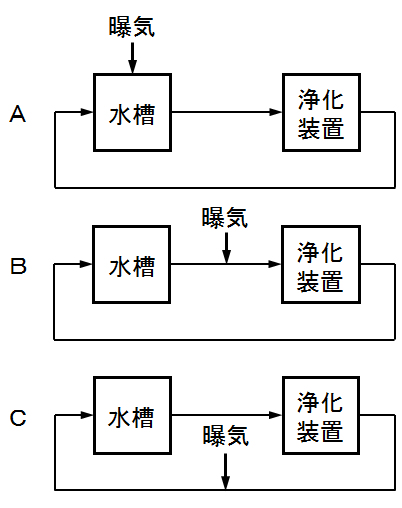
図6 システムフロー内の曝気位置
Fig.6. Aeration position in system flow.
曝気 aeration, 水槽 fish tank, 浄化装置 clarification device.
6.維持管理
6.1 生物膜の植種と育成
新しい浄化装置を設置したとき、生物膜の成長には日数を要するので直ちに浄化機能は期待できない。所定の収容量で浄化能力を正常に作動するまでに、1~2ヶ月の期間が必要である。一般に微生物の付着していない新しい浄化装置を稼働したとき、有機物酸化菌の増殖は速いが、アンモニア酸化菌は増殖が遅くこの菌が熟成するのには更に2~3週間程度要し、この後亜硝酸酸化菌が増殖してこの菌が十分に熟成するのに1~2ヶ月必要である [河合, 1964; Hirayama, 1974; Liao, 1979]。硝化反応のページの図に示すように、稼働初期にはアンモニアが蓄積して、10日ごろ最大値を示して減少し、その後亜硝酸が増加して30日ごろ最大値を示して減少する [Hirayama, 1974]。システム稼働後、10日~1ヶ月ごろ活魚の死亡事故がよく見受けられる。これは、アンモニアや亜硝酸イオンの濃度が高くなるからである。
(A) 通常、少しずつ魚の収容量を増加して浄化装置を熟成した後、正常運転に入る。または、スキムミルクなどを添加してもよい。この場合、活魚収容能力100kgの水槽では、投与量5g/日程度から初めて最終的に30g/日になるように、3~5日間隔で1ヶ月程度スキムミルクを投与するとよい。
(B) 一方、適当量の植種をすれば、浄化装置が早く機能する。植種は、正常に稼働している浄化装置の担体の一部を取り出して、海水中で攪拌して生物膜を剝離し、この懸濁液を採取する。剝離生物膜は沈降性がよいので、10~30分程度静置して上澄み液を除くことにより濃縮できる。この濃縮液(5~20g-バクテリア/L)をろ床容積の1/10程度投入する。最初海水は著しく懸濁しているが、数時間から半日程度で担体に捕捉されて透明になる。生物膜を培養して、これを植種している装置メーカーもある。
生物膜の植種と育成の具体的な操作については、他のページを参照されたい。
6. Maintenance
6.1 Biofilm seeding and breeding
When a new purification device is installed, the purification function cannot be expected immediately because it takes days for the biofilm to grow. It takes a period of 1 to 2 months for the purification capacity to operate normally with a given fish storage capacity. Generally, when a new purification device free of microorganisms is put into operation, the growth of organic-oxidizing bacteria is fast, but that of ammonia-oxidizing bacteria is slow and it takes about more 2 to 3 weeks for the bacteria to mature. It takes 1 to 2 months for nitrite-oxidizing bacteria suffiently to grow and mature [Kawai, 1964; Hirayama, 1974; Liao, 1979]. As shown in the figure on the page of nitrification reaction, ammonia accumulates at the beginning of operation and shows a maximum value around 10 days, and then nitrite increases and then reaches a maximum value around 30 days and decreases [Hirayama, 1974]. Death of live fish is often seen around 10 days to 1 month after system operation was started. This is because the concentrations of ammonia and nitrite ions are high.
(A) The normal operation is started, after gradually increasing the fish storage capacity to mature the clarification device. Alternatively, skim milk or the like may be added. In this case, it is advisable to administer skim milk at an interval of 3 to 5 days for about 1 month so that the dose reaches about 30g/day from the dose of about 5g/day for the tank with a capacity of 100kg-fish.
(B) On the other hand, if you plant a proper amount of seeds, the clarification device will function quickly. For planting, a part of the carrier is taken out from another purifying device that is operating normally, stirred in seawater to peel the biofilm out, and this suspension is setteled and collected. Since the detached biofilm has a good settling property, it can be concentrated by allowing it to stand for about 10 to 30 minutes to remove the supernatant. Add this concentrated liquor (5 to 20 g-bacteria/L) to about 1/10 of the filter bed volume. Seawater is remarkably suspended at first, but it becomes transparent by being captured by the carrier bed in about several hours to half a day. Some device manufacturers culture biofilm and provide it.
See another page for practical procedure of biofilm planting and breeding.
6.2 魚の収容量
魚の収容量は、浄化装置の能力により決定される。浄化能力以上の魚を収容すると、水質が悪化する。水質が悪い状態で運転すると、魚の生存期間が短縮したり、病原菌が増殖したり、異臭を放つカビ類が発生しやすい。
淡水魚と比較して、海水魚は濁りに弱い。簡単な収容能力の判断は濁りによって行う。すなわち、一度に大量の魚を投入して直後は海水が懸濁するが、半日~1日経過したとき、濁りが消失する場合には、浄化能力は十分であると判定する。
濁りが生じるからと言っても、有機物やアンモニア等の有害物質が必ずしも高いことを意味しない。浄化装置の能力以上の負荷により、水槽内で微生物が増殖していることを意味する。活魚水槽は、一般的に水量の3~6%程度の魚を収容できる能力になるように設計されている。この収容能力以内で懸濁するならば、浄化装置の設計または運転管理のいずれかが不適当であろう。
6.2 Fish capacity
Avairable amount of fish is determined by the capacity of the purifier. The water quality deteriorates if fish is stored more than the clarification capacity. When operated in poor water quality, the survival time of fish is shortened, pathogenic bacteria are proliferated, and molds that give off an offensive odor are easily generated.
Saltwater fish is less susceptible to turbidity than freshwater fish. Turbidity is used as an index to make a simple determination of fish capacity. That is, if a large amount of fish is thrown in at one time and seawater becomes to have suspended solid immediately after that, but if the turbidity disappears after half a day to a day, it is judged that the clarificating device ability is enough.
Turbidity does not necessarily mean that organic substances and harmful substances such as ammonia are high. It means that microorganisms are growing in the tank due to a load exceeding the capacity of the purifying device. Tanks are generally designed to have a fish capacity of about 3 to 6% of the water volume. If water has suspended solid always, either the purifier design or the operational control woud be inadequate.
6.3 水質分析
多くの活魚店・生け簀料理店では、水質分析は実施されていない。しかし、水質は魚の生存期間に著しく影響を与えるので水質分析は適正管理上、重要である。主な水質項目は次の通りである。なお、現場での簡易水質検査・測定については、別ページに掲載しているので、参考とされたい。
(1)温度、(2)溶存酸素、(3)pH、(4)透明度、(5)色度、(6)懸濁物質、(7)有機物、(8)アンモニア、(9)亜硝酸イオン、(10)硝酸イオン、(11)リン酸イオン、(12)塩分
上記の項目の中で、(1)温度、(2)溶存酸素、(3)pH、(6)懸濁物質、(8)アンモニア、(12)塩分は特に重要である。溶存酸素計やpHメーターは携帯用が便利である。pHは万能試験紙を用いれば簡単な測定ができ、アンモニアについては比色法による簡易分析キットは発売されている。塩分は比重計でチェックする。なお、pHメーターは、原理上、取扱いには注意が必要である。
6.3 Water quality analysis
Water quality analysis is not performed at all live fish stores and restaurants. However, water quality analysis is important for proper management because water quality significantly affects the survival time of fish. The main water quality items are as follows. Note that the simple water quality inspection or measurement on site is posted on a separate page, so refer to it.
(1) temperature, (2) dissolved oxygen, (3) pH, (4) transparency, (5) chromaticity, (6) suspended matter, (7) organic matter, (8) ammonia, (9) nitrous ion, (10) nitrate ion, (11) phosphate ion, and (12) salinity
Among the above items, (1) temperature, (2) dissolved oxygen, (3) pH, (6) suspended matter, (8) ammonia, and (12) salinity are particularly important. The dissolved oxygen meter and pH meter are convenient to use. The pH can be easily measured by using a universal test paper, and a simple colorimetric analysis kit for ammonia is on sale. Check the salt content with a hydrometer. The pH meter requires careful handling in principle.
6.4 pHの管理と海水の交換
(1) pHの管理
活魚水槽は閉鎖系であるので、難生物分解性有機物や酸化分解生成物である二酸化炭素、硝酸イオン、リン酸イオン等が蓄積するとともに、pHが低下する。また、ろ床内の微生物の代謝物である色素が蓄積する [Hirayama, 1988] 。
養殖系におけるこれらの汚濁物質の魚に対する影響は詳しく調べられている [Poxton, 1982] が、備蓄系においては研究例が少ない。二酸化炭素は曝気により除去される。硝酸イオンやリン酸イオンは急性毒性を示さないが、何らかの影響を与える。養殖系では化学的ストレスの原因となり成長率に影響するが、備蓄系では実験データが極めて少なく、経験的ノウハウによる管理が行われているので、科学的に不明なことが多い。
pHについても、どの程度の影響があるのか、数値的な知見は少ない。タイ・ブリ・ヒラメなどは、pH6程度まで低下しても、余り問題はないようである。しかし、海水を交換しないで長期間に渡って運転すると、浄化微生物への阻害物質が蓄積して、その浄化能力に低下する。特に、pHの低下とともに硝酸菌の活性が低下し、pH6以下になるとアンモニアの蓄積が顕著となる [河合, 1965; Richard, 1975; Enrique, 1979]。現場調査の結果では、pH6.5以上で、さらに硝酸イオン100mg/L以内に維持される程度に海水交換を行えば、特に問題は生じないようである。
また、Ca(OH)2、CaO、Mg(OH)2、MgOあるいはNaHCO3などを定期的に添加してpH7.5~8になるように中和してもよい。さらに、pHコントローラーを用いてpH制御を行う場合には、一般の活魚水槽ではpH6.5~7に設定するとよい。pH制御の設定値が高くなるほど、魚や浄化微生物の呼吸反応により排泄される炭酸ガスの中和に要する割合が高くなる。pH7以上では、pHの設定値が高くなるほど、アルカリ消費量が急激に増加し、薬品経費が高くなる。アルカリ添加はアンモニア酸化で消費されるアルカリの補充が主な目的であることに留意する。
養殖系ではpHが低下すると魚の摂餌活動が不活発となるが、活魚水槽では魚は衰弱しているので観察のみによる判定は困難である。
6.4 pH control and seawater exchange
(1) pH control
Since the live fish tank is a closed system, the non bio-degradable organic matter and the oxidative decomposition products such as carbon dioxide, nitrate ions and phosphate ions accumulate, and the pH drops. In addition, pigment (a metabolite of microorganisms) accumulates in the system [Hirayama, 1988].
The effects of these susbstances on fish in aquaculture systems have been investigated in detail [Poxton, 1982], but there are few studies in the stockpiling system. Carbon dioxide is removed by aeration. Nitrate and phosphate do not show acute toxicity but have some effect. In the aquaculture system, accumulated compounds cause chemical stress and affect the fish growth rate. However, in the stockpiling system, there are very few experimental data, and since it is managed by empirical know-how, it is often unknown scientifically.
There are few numerical findings on how much the pH affects. For sea bream, yellowtail, flounder, etc., it seems that there is no problem even if the pH is lowered to about 6. However, if it is operated for a long period of time without exchanging seawater, an inhibitory substance to the clarification microorganisms accumulates and its clarification capacity decreases. In particular, the activity of nitrification bacteria decreases with decreasing pH, and ammonia accumulation becomes remarkable at pH 6 or lower [Kawai, 1965; Richard, 1975; Enrique, 1979]. According to the results of the field survey, no particular problem seems to occur if the seawater exchange is carried out to the extent that keep the water at a pH of 6.5 or more and that the nitrate ion is maintained within 100 mg/L.
Ca(OH)2, CaO, Mg(OH)2, MgO, NaHCO3 or the like may be added periodically to neutralize the pH to 7.5 to 8. Furthermore, when performing pH control using a pH controller, it is recommended to set the pH to 6.5 to 7 in a general live fish tank. The higher the set value of pH control, the higher the ratio required to neutralize carbon dioxide gas excreted by the respiratory reaction of fish and microorganisms in purifier device. At pH 7 and above, the higher the set pH value, the more rapidly the alkali consumption increases, resulting in higher chemical costs. It should be noted that the main purpose of alkali addition is to replenish the alkali consumed in ammonia oxidation.
In aquaculture system, when the pH is lowered, the eating activity of fish becomes inactive, but in live fish tank, the fish are debilitated, so it is difficult to judge by observation alone.
(B) 海水の交換
海水の交換時に留意すべきことは、温度の急変である。同じ温度の海水を交換するか、温度が異なる場合には、全水量の1/5程度を交換する。いずれにしても、海水交換は全水量の1/3程度を超えない範囲が適切であろう。海水交換の頻度は、水槽の管理状況により異なるので、一般化が困難である。
(2) Exchange of seawater
What should be noted when exchanging seawater is a sudden change in temperature. Exchange seawater of the same temperature, or if the temperature is different, replace about 1/5 of the total water volume. In any case, the range of seawater exchange should be within the range of 1/3 of the total water volume. The frequency of seawater exchange depends on the management status of the tank, so it is difficult to generalize.
6.4 追記
活魚水槽を長期間使用すると、色素や阻害物質が蓄積するとともに、pHが低下するため、海水を入れ替えて中和剤を添加する必要があります。さらに、(1)pH および(2)塩濃度の制御に加えて、(3)UV照射を併用することで、次のよう水質改善が達成される。(a) 海水の交換回数の削減、(b) 難分解性有機物の分解、(c) 透明性を向上、および(d)病原菌の消毒。
6.4 Additions
If a live fish tank is used for a long period of time, pigments and inhibitors will accumulate and the pH will drop, so it is necessary to replace seawater and add a neutralizer. Furthermore, in addition to the control of (1) pH and (2) salt concentration, the combined use of (3) UV irradiation achieves the following water quality improvement. (a) Reducing the number of changes in seawater, (b) Decomposing persistent organic substances, (c) Improving transparency, and (d) Disinfecting pathogens.
(1) pHの管理
pHの管理には、炭酸水素ナトリウム(重曹)を用いると便利である。天然海水のアルカリ度は約2meq.であるので、pH試験紙を用いて検査し、pH6~6.5以下になったら、炭酸水素ナトリウム海水1m3当たり170~340g程度投与する(2~4meq.に相当し、pHは7.5~8程度となる。)。炭酸水素ナトリウムは加えすぎてもpHの急激な上昇がないので、簡便なpH管理には優れている。
また、焼成した酸化マグネシウムの球体状または楕円体状ペレット(粒径数cm)を用いれば、海水pH程度の範囲内で値が自然的に制御される。浄化槽ろ床上部に投入すれば、pH低下に伴い酸化マグネシウムが溶出して、海水を自然に中和する。ペレットが消失するまで中和機能が継続するので、消失する前にペレットを補充する。極めて便利な方法であるが、水槽や浄化槽の内壁(水面付近)に白色スケールが形成される欠点がある。ただし、魚に対して無害なものである。
(1) pH control
It is convenient to use sodium hydrogen carbonate (baking soda) to control the pH. Since the alkalinity of natural seawater is about 2 meq., test using pH test paper, and if the pH becomes 6 to 6.5 or less, administer about 170 to 340 g per m3-water of sodium hydrogen carbonate seawater (equivalent to 2 to 4 meq., pH will be about 7.5 to 8.) It is excellent for simple pH control because the pH does not rise sharply even if sodium bicarbonate is added too much.
If spherical or ellipsoidal pellets (particle size: several cm) of calcined magnesium oxide are used, the value is naturally controlled within the range of seawater pH. If added to the upper part of the biofilm filter, magnesium oxide will elute with decrease in pH, and seawater will be neutralized naturally. Since the neutralizing function continues until the pellets disappear, replenish the pellets before these disappear. Although it is an extremely convenient method, it has a drawback that a white scale is formed on the inner wall (near the water surface) of a water tank or a filter bed container. However, it is harmless to fish.
(2) 塩分濃度の管理
塩分濃度の管理は比重計を用い、水温15~20℃の場合には、1.024~1.026程度に維持されるようにする。水道水等の混入がない場合には、水分の蒸発により塩分濃度は増加するので、上記値を大きく上回るようであれば、水道水を補給して調整する。
注意すべきことは、水槽内の海水量が減少するごとに、海水のみを補給しているケースがある。この場合、塩分濃度が異常に増加して、魚介類だけでなく浄化装置内の微生物の活性度を損なう。比重計で測定して、水道水の補給により、上記の適正な値に調整する。
(2) Management of salt concentration
Use a hydrometer to control the salt concentration, and maintain it at around 1.024 to 1.026 when the water temperature is 15 to 20°C. If tap water is not mixed in, the salt concentration will increase due to evaporation of water, so if the value exceeds the above value, tap water should be replenished for adjustment.
It should be noted that there are some cases in which only seawater is replenished every time the amount of seawater in the tank decreases. In these cases, the salt concentration becomes abnormally high, damaging activities of not only the fish but also the microorganisms in the clarification device. Measure with a hydrometer and adjust to the appropriate value above by supplementing tap water.
(3) 紫外線照射
色素や阻害物質の除去には紫外線照射が効果的である。この理由は、難分解性物質や色素が紫外線によって、分解性物質へ変換されることによる。また、浮遊性微生物の殺傷により海水の透明度が向上するとともに、病原性細菌・ウイルス等の殺菌にも効果的である。
紫外線照射用ランプは、通常型と浸漬型がある。ただし、活魚水槽内への設置は避ける。
浸漬型は、浄化装置内または循環経路のパイプ内のいずれにも設置可能である。析出付着したスケールを定期的に除去(塩酸・硝酸の希釈液に30分程度浸漬、または、食酢の希釈液に半日程度浸漬)する必要がある。
通常型は、開放型浄化槽の上部に設置し、循環水の水面に照射する。紫外線は、人体、特に、目に対して極めて有害であるので、ランプ上部に覆いを付けて紫外線が外部へ漏れないように留意する。
1~2m3の水量に対して、15W程度の殺菌灯(紫外線ランプ)で十分である。
(3) UV irradiation
Ultraviolet irradiation is effective for removing pigments and inhibitors. The reason for this is that the hardly decomposable substance and dye are converted into decomposable substances by ultraviolet rays. In addition, the transparency of seawater is improved by killing floating microorganisms, and it is also effective for sterilizing pathogenic bacteria and viruses.
UV irradiation lamps are available in normal type and immersion type. However, avoid installing it in the live fish tank.
The immersion type can be installed either in the clarification device or in the pipe of the circulation path. It is necessary to regularly remove the deposited and adhered scale (immerse it in a dilute solution of hydrochloric acid or nitric acid for about 30 minutes, or soak it in a diluted solution of vinegar for about half a day).
The normal type is installed on the open filter bed and illuminates the circulating water surface. UV rays are extremely harmful to the human body, especially the eyes, so cover the top of the lamp to prevent UV rays from leaking to the outside.
A sterilizing lamp (ultraviolet lamp) of about 15 W is sufficient for the water volume of 1 to 2 m3.
6.5 微生物担体の再生
再生の時期は魚の収容量と浄化装置の能力によって異なる。図5に示す開放式の浄化装置では、ろ床の仕切り板をオーバーフローするようになると、再生が必要である。密封式(圧力計が必要)では、圧力損失が定格値に達したらとき、再生が必要となる。また、5.4節で述べたように、ろ床内の微生物保持量が飽和に達し、海水が異常な懸濁状になれば、再生を行う。通常、魚を投入する際に海水も補給されるので、魚の収容量と海水補給が適切であれば、ろ床内の微生物の自己分解と増殖とのバランスにより、数ヶ月~半年間に1回程度の再生となるように設計・施工するとよい。
ただし、水槽管理に熟知したユーザーでは、その限りでない。また、7.1節の事例1・事例2で述べるように、再生装置(手動あるいは自動)を有するものであれば、その仕様に沿って再生すればよいので、その簡素化が可能となる。
6.5 Regeneration of microbial carrier
The timing of regeneration depends on the amount of fish and the capacity of purifier. In an open type clarification apparatus shown in Fig.5, when water begins to flow over the partition plate of filter bed, regeneration is necessary. A sealed type (with a pressure gauge) requires regeneration when the pressure loss reaches a rated value. Also, as described in Section 5.4, when the amount of microorganisms retained in the filter bed reaches saturation and the seawater becomes to contain abnormal suspended solids, the filter bed should be regenerated. Normally, seawater is also replenished when fish is transfered in, so if the fish storage amount and seawater replenishment are appropriate, the regeneration will be need once every several months to a half year due to the balance between autolysis and growth of microorganisms in the filter bed. It is recommended to design and construct so that above. This may not apply all to users who are familiar with tank management.
As described in Cases 1 and 2 in Section 7.1 below, if the apparatus has a reproducing device (manual or automatic), the reproduction can be performed according to the specifications thereof, so that the simplification can be achieved.
6.6 カビや病原菌の発生
装置の設計や担体の選定あるいは維持管理が不適切で、水質が悪い状態で運転するとカビ類や腐敗菌が発生して魚が異臭を放つようになる。この臭いは魚の中身まで及び商品とならない。さらに、病原菌が繁殖して魚が感染しやすくなる。運転しながらカビ類や病原菌の駆除は困難である。このような状態になったら、水槽・浄化装置を滅菌後、水洗して再稼働する方法が最も効果的である。しかし、予備水槽がない場合が多く、実際にはには滅菌・洗浄・植種・再稼働の処置は営業上極めて大きな損失となる。
漁港や市場などの大規模水槽には多くの魚が集積され、季節の変わり目(春先や秋口)には感染魚が混入しやすい。病原菌は流通ルートを通じて、各地に伝染するので水槽の病原菌対策は特に注意を払う必要がある。取引している市場などの水槽が病原菌で汚染されるいる時、流通末端の鮮魚店や料理店等の水槽の管理をいくら適正に管理しても、次々に感鮮魚が入ってくれば手の打ちようがない。病原菌対策は流通経路の元からその対策を講じる必要がある。
6.6 Outbreak of mold and pathogens
Poor equipment design, carrier selection or maintenance, and poor water quality operation can cause mold and spoilage bacteria to give offensive odors to fish. This odor reaches the contents of the fish and is not a commodity. In addition, pathogenic bacteria propagate and fish are more susceptible to infection. Eliminating mold and pathogens while driving a fish system is difficult. In these situations, the most effective method is to sterilize the water tank and the purifier, flush with water and restart. However, in many cases, there are no spare tanks, and in fact, sterilization, cleaning, seeding, and recommissioning result in a huge loss to the business.
Many fish are gathered in large-scale tank such as fishing ports and markets, and infected fish are prone to mix at seasonal changes (early spring and autumn). Since pathogenic bacteria are transmitted to various places through distribution routes, it is necessary to pay particular attention to measures against pathogenic bacteria in tanks. If the tank in a markets you are trading is contaminated with pathogenic bacteria, no matter how properly you manage the tanks at the live fish stores or restaurants (at the end of the distribution), when you trade in infected fish one after another, you can do nothing. It is important to take measures against pathogenic bacteria from the source of distribution channels.
7.活魚水槽と浄化装置の具体例
7.1 遊泳魚用大型水槽
大型のタイ、ブリなどの遊泳魚および大型のヒラメの備蓄には5~10m3程度の水槽が多く用いられている。図7および図8に、その事例を示す。なお、以下に示す容積は有効容積を示す。
7. Examples of live fish tanks and clarification devices
7.1 Large tank for swimming fish
A large water tank of about 5 to 10 m3 is often used for stockpiling large swimming fish such as sea bream and yellowtail, and large flounder. The case is shown in Figs. 7 and 8. The volumes shown below are effective volumes.
事例1-活魚店-
図7は、山口県内のある鮮魚店に設置してあるもので、コンクリート製6m3の水槽とアクリル製1m3の水槽から構成されている。6m3の水槽には、1kg以上のタイ、2.5kg前後のメジ、1kg以上のヒラメ、1kg以上の石ダイなどの大型の魚を備蓄している。通常、1週間の平均的備蓄・販売量は400kg前後で、連休、盆や暮には、800kgである。具体的には、1週間に2回搬入し、3~4日程度で販売されている。1m3の水槽には、フグ、アジ、カワハギ、1kg以下のタイ類など、中型・小型の遊泳魚や伊勢エビを備蓄している。
浄化装置は2階に設置、仕切りによってFRP製3槽で構成され、第1槽は貯留槽、第2槽および第3槽がろ床を有し、上向流式である。海水の循環時間は70分である。装置容積3m3の内、ろ床の総容積は1.6m3で水槽容積の1/4.5である。生物担体は、2槽ともサイズの異なる玉砂利(下層よりそれぞれの平均径3cm、1cm、3mm)を3層に分けて充填してあった。
水質は著しく悪化して、海水は懸濁し、水槽表面にはスカムが多量に存在していた。この水質悪化の原因は、浄化装置を設置後、一度も再生が行われていなかったことにある。再生装置がないので、再生操作は浄化槽内の玉砂利を取り出して洗浄する方法しかない状況であった。この操作には、各槽につき学生5人で8時間程度を要する作業量(用具等の準備は別)であった。
そこで、ろ床底面に散気装置を取り付け、比重が水よりも僅かに大きい炭素系・連続性多孔質担体(粒径数cm)を充填し、空気曝気により担体を流動・攪拌して生物膜の剝離・洗浄が可能な浄化装置へ仕様変更した。なお、本来の浄化装置は2槽の担体充填槽を有しているので、交互に再生を行うことにより、海水の浄化機能を連続して維持することが可能なものである。この仕様変更により、写真1Aと写真1Bに示すように水質が著しく改善された。
この活魚店では浄化装置の再生に関する知識がなく、再生に要する労力と経費に係わる維持管理上の課題を示す代表的な事例である。
Case 1 – Live fish shop –
The tank system shown in Fig.7 is installed at a fish shop in Yamaguchi Prefecture, Japan, and is composed of a concrete 6m3 water tank and an acrylic 1m3 water tank. The 6m3 tank holds large fish such as 1kg or more of sea bream, 2.5kg or more of amberjack, 1kg or more of flounder, and 1kg or more of stone bream. Normally, the average stockpile/sales amount for one week is usually about 400 kg, and 800 kg for consecutive holidays, Obon and year-end days. Specifically, it is delivered twice a week and sold out in about 3 to 4 days. The 1m3 tank contains less than 1kg of medium and small swimming fish such as puffer fish, horse mackerel, filefish, and sea bream, and Japanese spiny lobster.
The clarification device is installed on the second floor and consists of three FRP tanks with partitions. The first is an adjustment tank, the second and the third tanks have filter beds of upflow type. The circulation time of seawater is 70 minutes. Of the device volume of 3m3, the total volume of the filter beds is 1.6m3, which is 1/4.5 of the fish tank volume. Both tanks had a filter bed divided into 3 layers.The biological carriers were gravels of average diameter 3cm, 1cm and 3mm respectively from the bottom layer.
The water quality deteriorated significantly. The seawater contained suspended solid and a large amount of scum was present on the water surface. The cause of this deterioration in water quality is that the filter beds were never regenerated after the clarification device was installed. Since there is no regenertor, the only way to regenerate the filter beds was to take out the gravels in the filter tanks and to wash them. This operation required about 8 hours for 5 students in each tank (preparation of tools etc. was not included).
Therefore, an air diffuser was attached to the bottom of the filter bed, and a carbon-based, continuous porous carrier (particle size: several cm), whose specific gravity was slightly larger than that of water, was filled, and the carrier was able to be moved and agitated by air aeration to detach excess biofilm on the carrier. Since the original device has two carrier-filling tanks, it is possible to continuously maintain the clarificating function of seawater by alternately regenerating each fiter bed. This change in specifications significantly improved the water quality as shown in Photo 1A and Photo 1B.
This live fish shop has no knowledge of regenerating clarification device, and this is a typical example showing maintenance issues related to labor and cost required for regeneration.
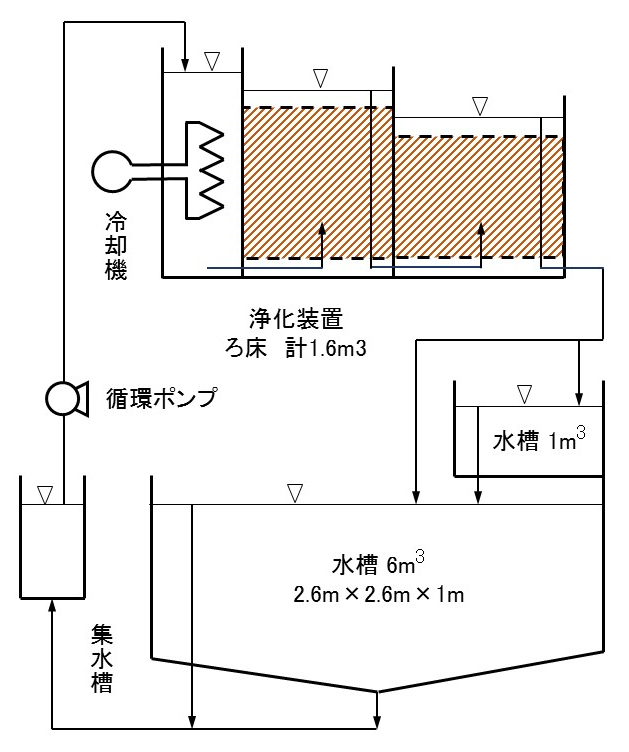
図7 鮮魚店における活魚水槽 Fig.7. Live fish tank in a store.
水槽 fish tank, 浄化装置 clarification device, ろ床 filter bed, 集水槽 water collection tank, 循環ポンプ water circulation pump, 冷却機 cooler.
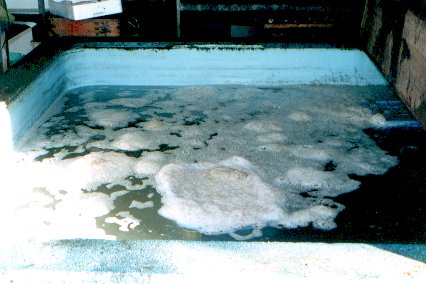
写真1A 仕様変更前の6m3水槽
Photo 1A. 6m3 water tank before specification change.
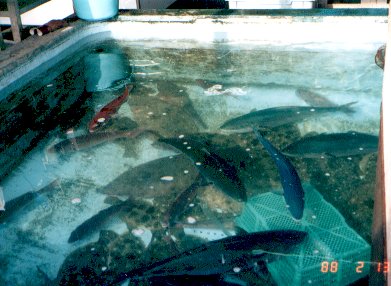
写真1B 仕様変更後の6m3水槽
Photo 1B. 6m3 water tank after specification change.
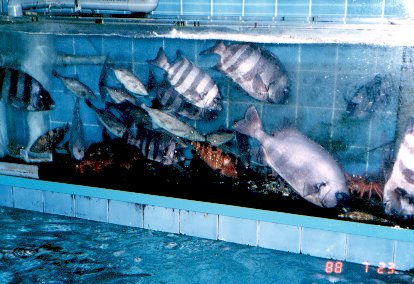
写真1C 仕様変更後の1m3水槽
Photo 1C. 1m3 water tank after specification change.
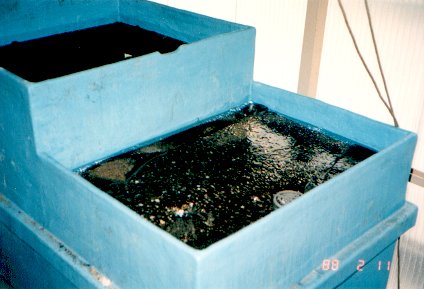
写真1D 仕様変更後の浄化装置
Photo 1D. clarification device after specification change.
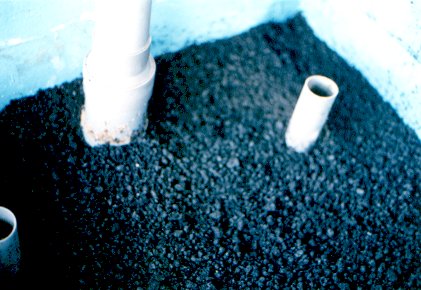
写真1E 仕様変更直後の浄化装置(第2ろ床)
Photo 1E. Second filter bed after specification change.
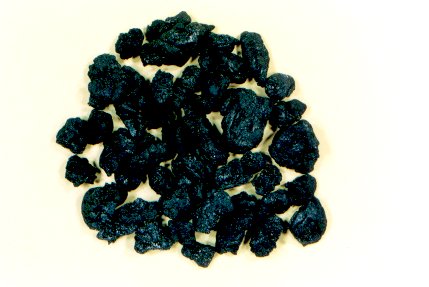
写真1F 炭素系充填材
Photo 1F. Carbon-based biofilm carrier.
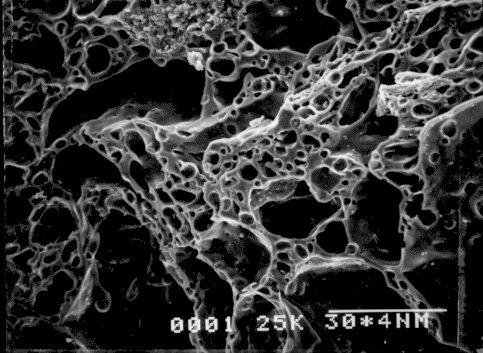
写真1G 炭素系充填材・断面の電子顕微鏡写真
Photo 1G Electron micrograph of cross section of carbon-based biofilm carrier.
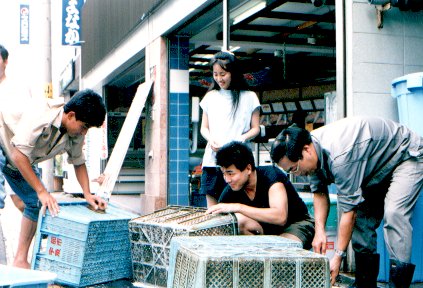
写真1H 作業中の学生
Photo 1H. Students at work.
事例2 – 活魚料理店 –
図8は、山口県のある活魚料理店に設置してある大型・中型遊泳魚用水槽を示す。この水槽は10m3および2m3の容積を有する2槽よりなり、いずれもコンクリート製である。10m3の水槽にはタイ、ヒラメ、メジ、ブリ、小型フカ、クエなど、1kg以上の大型魚を備蓄し、2m3には1kg以下の中型・小型の遊泳魚を備蓄している。
この水槽・浄化装置のフローは、まず水槽の海水を槽底およびオーバーフローパイプより集水槽に導く。この海水は曝気槽を通過した後、循環ポンプにより密封型の浄化装置内を経由して、冷却用熱交換器を経て備蓄水槽へ返送している。海水の循環時間は60分である。曝気槽の目的は、酸素供給のみでなく、曝気により微細な懸濁物質を気泡に付着凝集させて、浄化装置内の生物膜への捕捉効率を向上させることにある。
この曝気槽には、図9Aに示すものと同じ形状の担体(写真2G)を充填してある。この充填剤により槽内の気泡が垂直に上昇せず複雑な経路を経て上昇し、気泡の槽内での滞留時間を長くして気液接触の効率を上げている。
浄化装置内のろ床容積は0.66m3で、水槽容積の1/18である。水槽に対するろ床の容積比が小さいのは密封式の特徴である。
この浄化装置には連続性多孔質セラミック担体(写真2F)を充填している。この浄化装置には、曝気式再生法を採用しており、5分程度で再生が可能である。この水槽の水質の一例を表1のNo2に示す。
なお、本料理店には、イカ専用水槽や淡水魚専用水槽も設置されており、いずれも、水槽・浄化装置の設計・施工および維持管理が適正に行われている事例(設計の段階から、ユーザー・メーカー・本掲載者が連携)として紹介した。
Case 2 – Live fish restaurant –
Figure 8 shows a large and medium-sized swimming fish tanks installed in a live fish restaurant in Yamaguchi Prefecture. This system consists of two fish tanks with a volume of 10m3 and 2m3, both made of concrete. The 10m3 tank stores large fish of 1kg or more such as sea bream, flounder, Japanese mackerel, yellowtail, small shark and longtooth grouper, and the 2m3 tank stores medium and small swimming fish of 1kg or less.
The flow of these tanks and clarification device first guides the seawater from the fish tanks to the water collection tank through each fish tank bottom and overflow pipe. After passing through an aeration tank, this seawater is returned to the fish water tanks via the inside of a sealed clarification device and finally via a cooling heat exchanger, by a circulation pump. The circulation time of seawater is 60 minutes. The purpose of the aeration tank is not only to supply oxygen, but also to improve the efficiency of trapping the fine suspended solids on the air bubbles by aeration to trap them in the biofilm bed of the purification device.
This aeration tank is filled with fillers(Photo 2G) having the same shape as that shown in Fig. 9A. With these fillers, the bubbles in the tank do not rise vertically but rise through complicated pathes, increasing the residence times of the bubbles in the tank and increasing the efficiency of gas-liquid contact.
The filter bed volume in the clarification device is 0.66 m3, which is 1/18 of the total fish tank volume. The small volume ratio of the filter bed to the fish tank is a characteristic of the sealed type. The purifying device is filled with continuous porous ceramic carriers (Photo 2F). This purifier uses an aeration type regeneration method and can be regenerated in about 5 minutes. An example of water quality in this system is shown in No.2 of Table 1.
In addition, this restaurant is also equipped with a water tank only for squid and also another water tank only for freshwater fish. For this restaurant, the design, construction and maintenance of the water tanks and clarification devices were carried out properly (the user, manufacturer, constructor and editor worked together). This case is described as a good one.
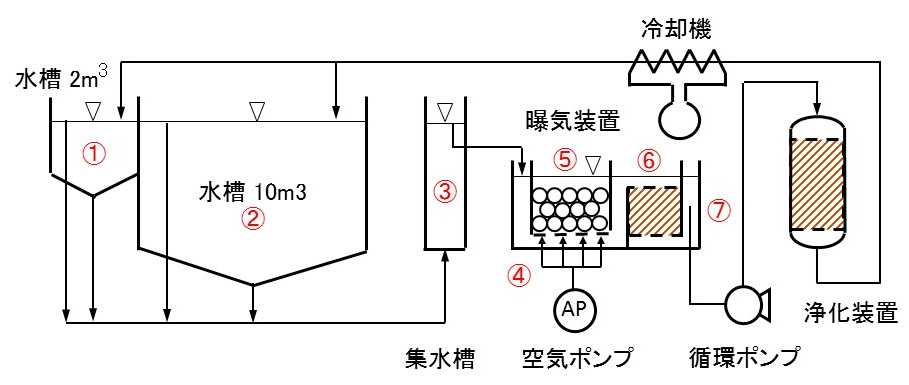
図8 活魚料理店における活魚水槽
各槽の溶存酸素濃度DO [mg/L, 15℃]: ① 8.8; ② 8.4; ③ 8.0; ④ 12.4; ⑤ 12.3; ⑥ 11.3; ⑦ 9.1
Fig.8 Live fish tank in a restaurant.
Dissolved oxygen concentration DO [mg/L, 15℃] in each tank: ① 8.8 (medium tank); ② 8.4 (large tank); ③ 8.0 (water collection tank); ④ 12.4 (bottom of aeration tank); ⑤ 12.3 (upper of aeration tank); ⑥ 11.3 (upper of filter bed); ⑦ 9.1 (in discharge pipe of circulation pump).
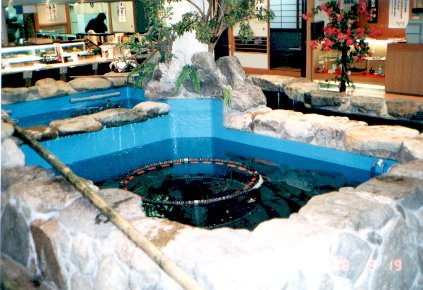
写真2A 大・中水槽全景
Photo 2A. Panoramic view of large and medium tanks.
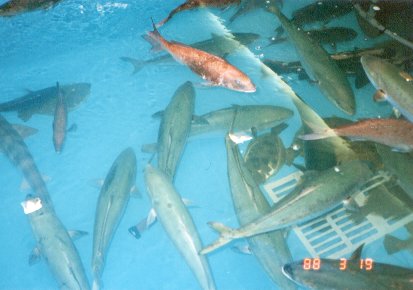
写真2B 10m3水槽
Photo 2B. 10m3 fish tank.
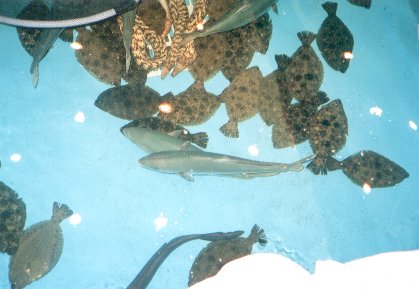
写真2C 10m3水槽
Photo 2C. 10m3 fish tank.
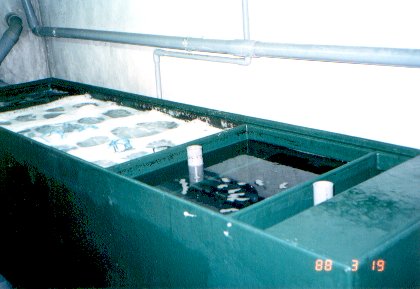
写真2E 浄化装置全景
Photo 2E. Panoramic view of purification device.
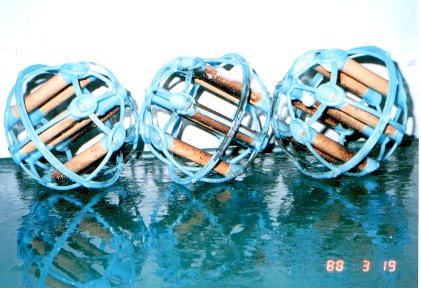
写真2G 曝気槽充填剤
Photo 2G. Aeration tank filler.
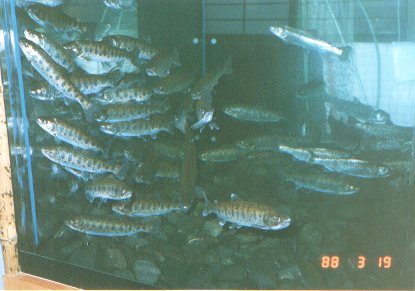
写真2H 淡水魚(ヤマメ)用水槽
Photo 2H. Tnank for cherry salmon.
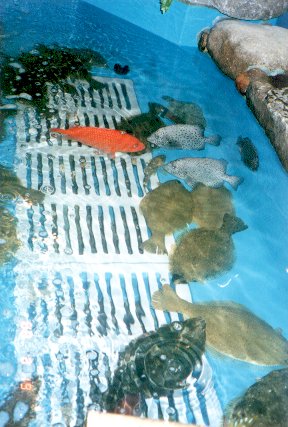
写真2D 2m3水槽
Photo 2D. 2m3 tank.
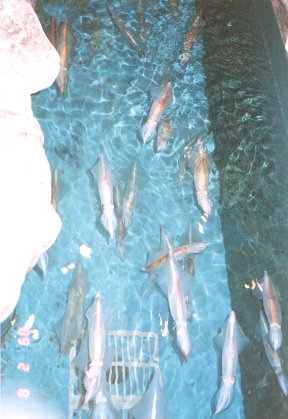
写真2I イカ専用水槽
Photo 2I. Tank only for squid.
写真2F: 同写真にリンクされている文献のタイトルは「淡水化」となっているが、同文献に記載の「多孔質セラミックス」と同じ製法・物性を有するものである。
Photo 2F: The title of the literature linked to the photograph is “desalination”, but it has the same manufacturing method and physical properties as the “porous ceramics” described in it.
7.1 追記
図7および図8に示す水槽いずれも、槽底およびオーバーフローパイプから海水を引き出している。槽底はテーパを設け、吐き出し物、糞などの沈降性物質を引き出している。一方、水槽で曝気を行うと気泡に懸濁物質が付着する。この気泡をオーバーフローパイプにより取り出す。水槽内で曝気を行う場合には、オーバーフローパイプは欠かせないものである。また、オーバーフローパイプは、水槽の水位を所定の高さに維持する機能も有する。
7.1 Additions
In each system shown in Figs. 7 and 8, seawater is drawn both from the bottom and overflow pipe of the fish tank. The bottom is tapered to draw out sedimentary substances such as vomits and feces. On the other hand, when aeration is performed in a fish tank, suspended substances adhere to the bubbles. The foams on the water surface are taken out by an overflow pipe. An overflow pipe is indispensable when performing aeration in a fish tank. The overflow pipe also has a function of maintaining the water level in the water tank at a predetermined height.
7.2 遊泳魚用小型水槽
図9に、0.5m3の小型水槽の一例を示す。この水槽は、図8に示す水槽をコンパクト化したもので、その背面に曝気槽を付設している。水槽内の海水はこの曝気槽を経て、ろ床内の微生物により処理された後、循環ポンプ、冷却用熱交換器を経て、水槽へ返送している。曝気槽内には図9に示すような気泡上昇を乱流させる充填材(直径14cmの玉型、写真2G)を設置し、浄化槽ろ床には図8に使用しているセラミックス系担体(写真2F)を充填している。海水の循環時間は30分である。この水槽の鮮魚店等での中小型の遊泳魚(アジ、カワハギなど)に適している。また、これは図3Aと同じタイプの水槽であり、大量の貝類の備蓄にも適している。
なお、この図の各槽の溶存酸素を示すように、フロー内で酸素を最も消費するのは、水槽内の魚ではなく、ろ床内の微生物である。
7.2 Small tank for swimming fish
Fig.9 shows an example of small fish tank of 0.5m3. This system is a compact version that is shown in Fig.8, and has an aeration tank attached to the back side of fish tank. The aerated seawater is treated by microorganisms in the filter bed and then returned to the fish tank through a circulation pump and a heat exchanger for cooling. In the aeration tank, packing materials (sphere shape with a diameter of 14cm, see Photo 2G) is used that cause turbulent flow of bubbles as shown in Fig.9, and in the clarification filter bed, the ceramic carriers (Photo 2F) are filled as shown in Fig.8-⑤. The circulation time of seawater is 30 minutes. It is suitable for small and medium-sized swimming fish (horse mackerel, riverfish, etc.) for live fish shops. Further, this is the same type as in Fig.3A, and is also suitable for stockpiling a large amount of shellfish.
It should be noted that, as shown by the dissolved oxygen value in each tank in this figure, it is not the fish that consume the most oxygen in the system, but the microorganisms in the filter bed.
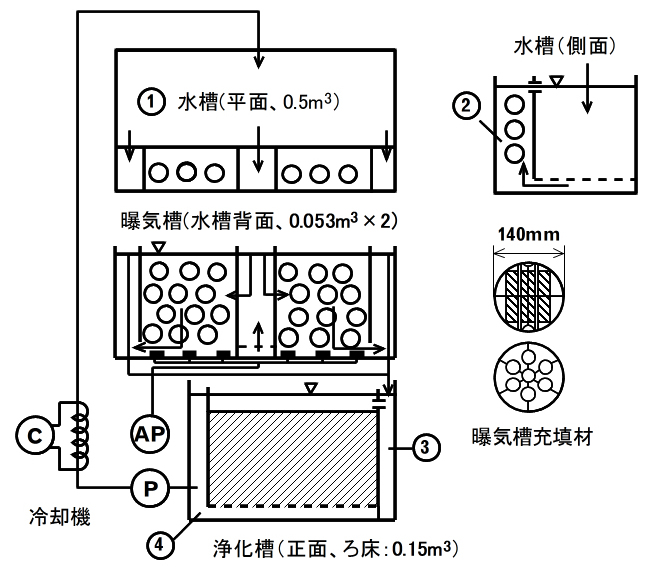
図9 遊泳魚用小型水槽
各槽の溶存酸素濃度DO [mg/L, 20℃]: ① 8.2; ② 10.5; ③ 9.6; ④ 7.3
Fig.9. Small aquarium for swimming fish.
Dissolved oxygen concentration DO [mg/L, 20℃] in each tank: ① 8.2; ② 10.5; ③ 9.6; ④ 7.3
水槽 fish tank (平面 plane, 背面 back, 側面 side), 曝気槽 aeration tank, 曝気槽充填剤 aeration tank filler, 浄化槽 purification tank (ろ床 filter bed)
7.3 底生魚・貝類・カニ・エビ用水槽
図10および図11に鮮魚店等に設置されている大中型以外の魚介類に用いられる水槽の事例を示す。図10は多段式の水槽である。
これらの水槽は水深が浅く(20~25cm)、多数の小穴を有する仕切り板により多槽に分割されているので、中小型底魚、貝類、カニ、エビ等の魚介類の種別ごと、サイズごとに分けて備蓄できる。
また、この浄化装置の特徴は、ろ床が浅い(30~40cm)ので、担体を取り出して再生できる。この浄化装置には砂(平均粒径2mm)が充填してあり、ろ床容積は水槽容積に対して、図10では1/3.5、図11では1/2と大きく設定されている。貝類や底魚は、遊泳魚と比較して、水槽内の収容比率が高いのでろ床の容積を大きくする必要がある。この水槽の水質の一例を表1のNo.4およびNo.5に示す。担体の粒径が小さく、懸濁物質の除去率も極めて良好である。曝気は、ディフーザーを分割した各水槽へ入れて、曝気を行っている。
7.3 Fish aquarium for shellfish, shellfish, crab and
shrimp
Figures 10 and 11 show examples of tanks used for fish and shellfish other than large and medium-sized fish, which are installed in live fish stores. Fig.10 shows a multi-stage tanks.
These tanks have a shallow water depth (20 to 25 cm) and are divided into multiple tanks by partition plates with a large number of small holes which can stock vearious speices of fish separately.
Also, the feature of these clarification device is that the filter bed is shallow (30 to 40 cm), so the carrier can be easely taken out and regenerated. This purifier is filled with sand (average particle size of 2 mm), and the filter bed volume is set to, respectively, 1/3.5 in Fig.10 and 1/2 in Fig.11 of each fish tank volume.
Compared to swimming fish, shellfish and bottom fish have a higher storage ratio in the tank, so the filter bed needs to have a larger capacity. Examples of the water quality of these systems are shown in No.4 and No.5 of Table 1. The carrier has a small particle size, and the removal rate of suspended matter is extremely good. Aeration is performed by putting the diffuser into each divided tank.
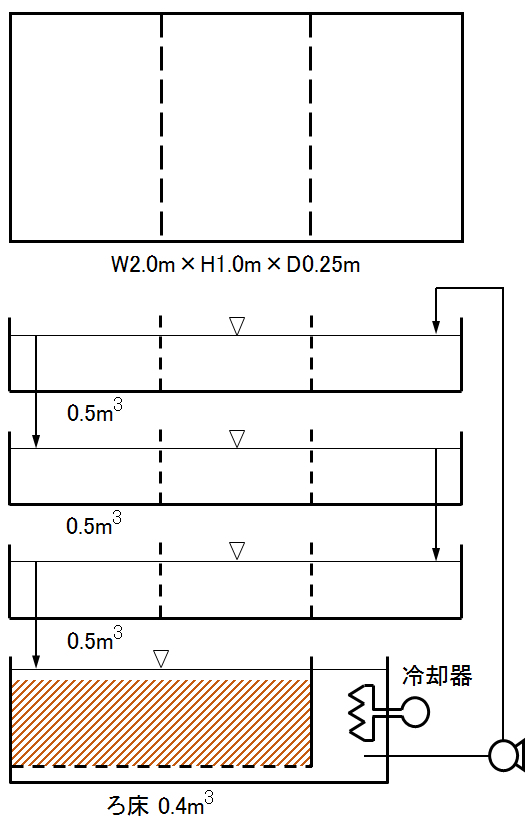
図10 底生魚・貝類用多段式水槽
Fig.10. Multi-stage aquarium for benthic fish and shellfish.
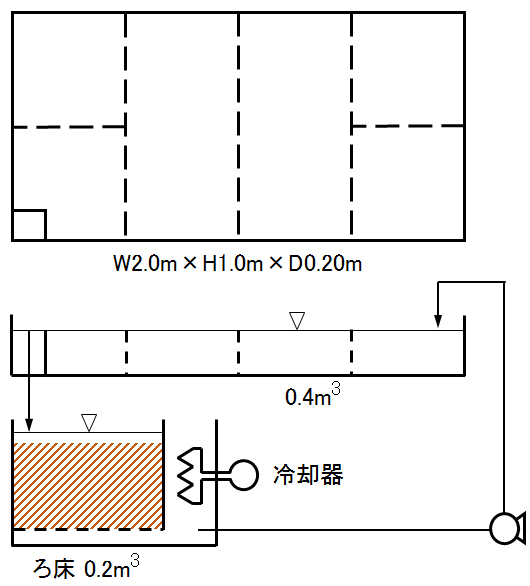
図11 カニ・エビ用水槽
Fig.11. Aquarium for crab and shrimp
Table 1. Example of water quality analysis of each live fish tank.

水質項目単位 water quality item unit [mg/L]; 担体 carrier: 砂利 gravel, 炭素系 carbon-based; 遊漁用大型水槽 large tank for swimming fish, 遊泳魚用小型水槽 small tank for swimming fish, 底生魚用小型水槽 benthic fishi, カニ・エビ用水槽 small tank for crab and shrimp.
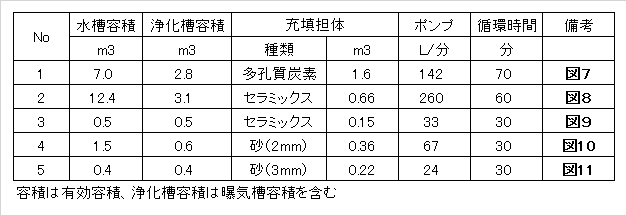
水槽容積 tank volume, 浄化槽容積 clarification device volume (including aeration part), 充填担体 filled biofilm carrier (多孔質担体 porous carbon-based, セラミックス ceramics, 砂 sand), ポンプ pump, 循環時間 water circulation tme, 備考 remarks.
8.おわりに
本編集者の幼少時代には、沿岸から離れた地域では、魚と言えば、干物や塩漬であった。昔は、新鮮な魚は高価なものであった。冷蔵輸送の手段もなく、魚の刺身などは、春・秋のお祭りや慶事の時以外に食する機会はなかった。活魚料理がブームとなって久しい。今日、活魚の販売ルートおよび活魚の輸送・備蓄技術の開発により、全国各地の一般消費者の手に届くようになった。
さて、産地から一般消費者に届くまでには、魚の鮮度も落ちる。また、天然活魚は天候等により安定した供給が困難である。一方、活魚店や料理店等では活魚を毎日販売しなければならない。
したがって、活魚を一定期間備蓄する必要がある。長時間の備蓄には、水質を清浄に保つ必要がある。従来、水槽、装置、水質等について基礎的研究が少なく、経験的に技術開発が行われていた。魚の収容量と水槽容積・ろ床容積などの設計は、担体の性能に係わらず同じような設計条件で行われており、現在、備蓄水槽の問題点の多くは、状況に応じた生物担体の選定とこれらの管理にあるようである。
水槽のユーザーが水浄化の原理や運転管理の知識に欠けることが多い。したがって、水槽・装置の設計・施工が適切であっても、運転管理が不十分のため、魚が短時間で死んだり、魚の鮮度が落ちている事例も見られる。ユーザーに対する浄化の原理や運転管理についての教育も必要であると感じる。本解説がこれらの一助になれば幸いである。
8. Conclusion
When the editor was a kid, we lived far off the coast and got dried fish and salted products. At that time, fresh raw fish was expensive. There was no means of refrigerated transportation, and we had no chance to eat sliced raw fish “sashimi” except at spring and autumn festivals and celebrations. Now, with the development of live fish sales routes, live fish transportation, and storage technology, it has become available to general consumers nationwide. Live fish dishes have been booming for a long time.
By the time it reaches the consumer from the fishing ground, the fish will lose its freshness. In addition, it is difficult to stably supply raw fish due to bad weather. On the other hand, live fish stores and restaurants need to sell these every day.
Therefore, live fish should be stored for a period of time. For long-term storage, water quality should be kept clean. Conventionally, basic researches on tanks, clarification equipments, water qualities, etc. have been limited, and technical developments have been conducted empirically. Some designs, such as fish storage capacity and tank/filter bed volume ratio, are performed under similar design conditions regardless of the performance of purifier. Currently, it seems that most of the problems with storage tanks are improper bio-carrier selections and/or these poor maintenances, without according to the situations.
The fish tank users often lack knowledge of water purification principles and operational management. Therefore, even if the design and construction of the tank and auxiliary equipment are proper, the management may be insufficient and the fish may die in a short time or the freshness may drop. Editors feel that they need to educate their users on the principles of water purification and process operation, and hope this page will help them.
参考文献
1) Bower, C.E., and J.P.Bidwell, 1978: J.Fish.Res.Board Can., vol.35, pp.1012-1016.
2) Colt,J., and G.Tchobanoglous, 1976: Aquaculture, vol.8, pp.209-224.
3) Enrique, J.La.Motta, M.Asce and Wen K.Shieh, 1979: Proc.Amer.Soc.Civil Eng., EE4, p.105.
4) Hirayama,K., 1970: Bull.Jpn.Soc.Sci.Fish., vol.36, pp.26-34.
5) Hirayama,K.,1974: Aquaculcure, vol.4,pp.369-385.
6) Hirayama,K., H.Mizuma, and Y.Mizue, 1988: Aquacultural Engineering, vol.7, pp.73-87.
8) Liao,P.B., and R.D.Mayo, 1974: Aquaculture, vol.3, pp.361-385.
9) Nicol,J.A.C, 1967: Biology of Marine Animals, p.699, Pitman, London.
10) Poxton,M.G, and S.B.Allouse, 1982: Aquacultural Engineering, vol.1, pp.153-191.
11) Richard,F.S., and A.Baggaley, 1975: J.WPCF, vol.42, pp.472-486.
12) 河合章,吉田陽一,木俣正夫,1964:日本水産学会誌, vol.30, pp.55-62.
13) 河合章,吉田陽一,木俣正夫,1965:日本水産学会誌, vol.31, pp.65-71.
14) 北尾高嶺, 1979: 環境技術研究会編,”下水・排水・汚泥ガイドブック”, pp.445-464, 理工新社.
15) 佐伯有常, 1958:日本水産学会誌, vo.23, 684-695.
16) 平山和次, 1965:日本水産学会誌,vol.31, pp.983-990.
17) 平山和次, 1966:日本水産学会誌,vol.32, pp.20-27.
18) 平山和次, 1966:日本水産学会誌,vol.32, pp.106-111.
19) 山崎隆義, 1982:日本水産学会編,”水産学シリーズ39 活魚輸送”, p.100, 恒星社厚生閣.
References
References 1) to 11) are shown in the left column.
The following 12) to 19) are all in Japanese.
12) Kawai, A., Y. Yoshida, M. Kimata, 1964: Nippon Suisan Gakkaishi (Journal of the Japanese Siciety of Fisheries Science), vol.30, pp.55-62.
13) Kawai, A., Y. Yoshida, M. Kimata, 1965: Nippon Suisan Gakkaishi, vol.31, pp.65-71.
14) Kitao, T., 1979: Environmental Technology Study Group, “Sewage/Drainage/Sludge Guidebook”, pp.445-464, Riko Shinsha.
15) Saeki, Y., 1958: Nippon Suisan Gakkaishi , vo.23, 684-695.
16) Hirayama, K., 1965: Nippon Suisan Gakkaishi, vol.31, pp.983-990.
17) Hirayama, K., 1966: Nippon Suisan Gakkaishi, vol.32, pp.20-27.
18) Hirayama, K., 1966: Nippon Suisan Gakkaishi, vol.32, pp.106-111.
19) Yamazaki, T., 1982: the Japanes Society of Fisheries Science edited, “Fisheries Science Series 39, Live Fish Transport”, p.100, Koseisha Koseikaku.
